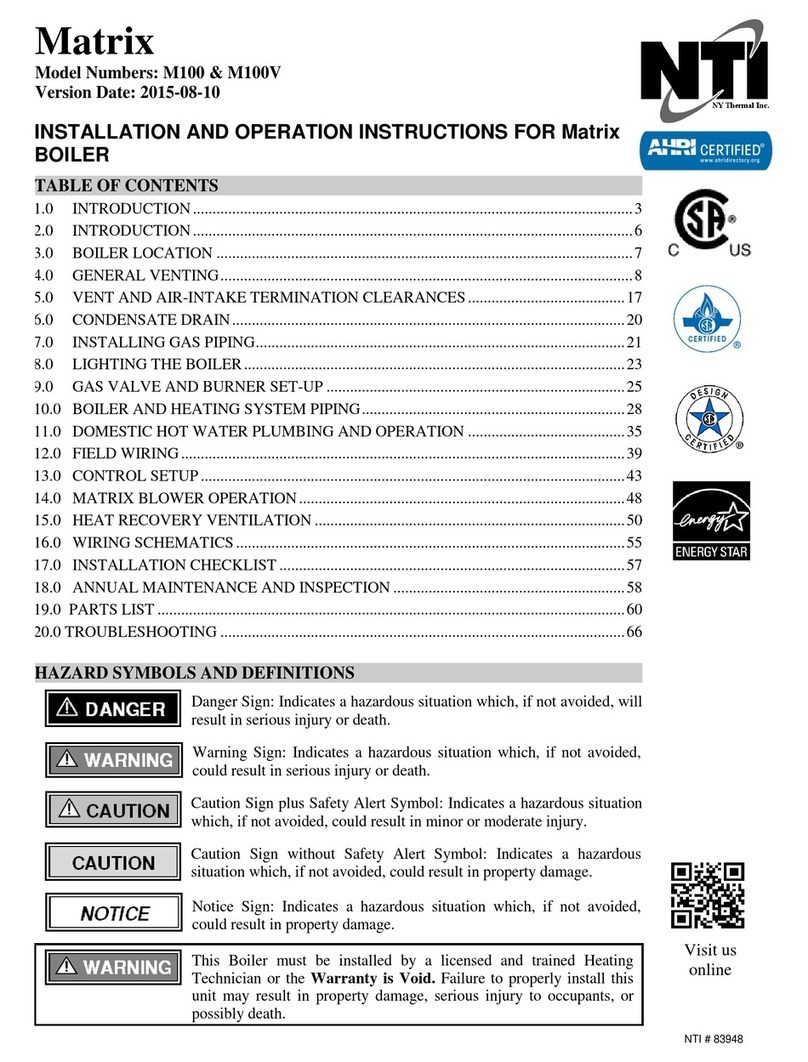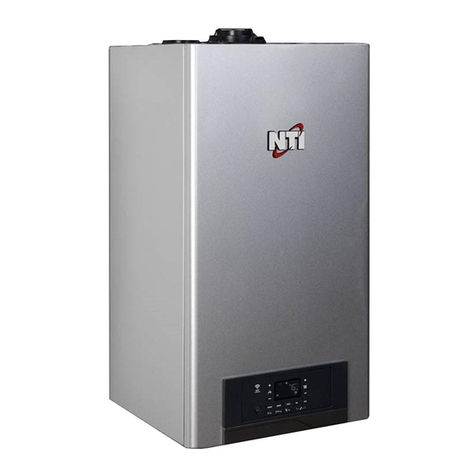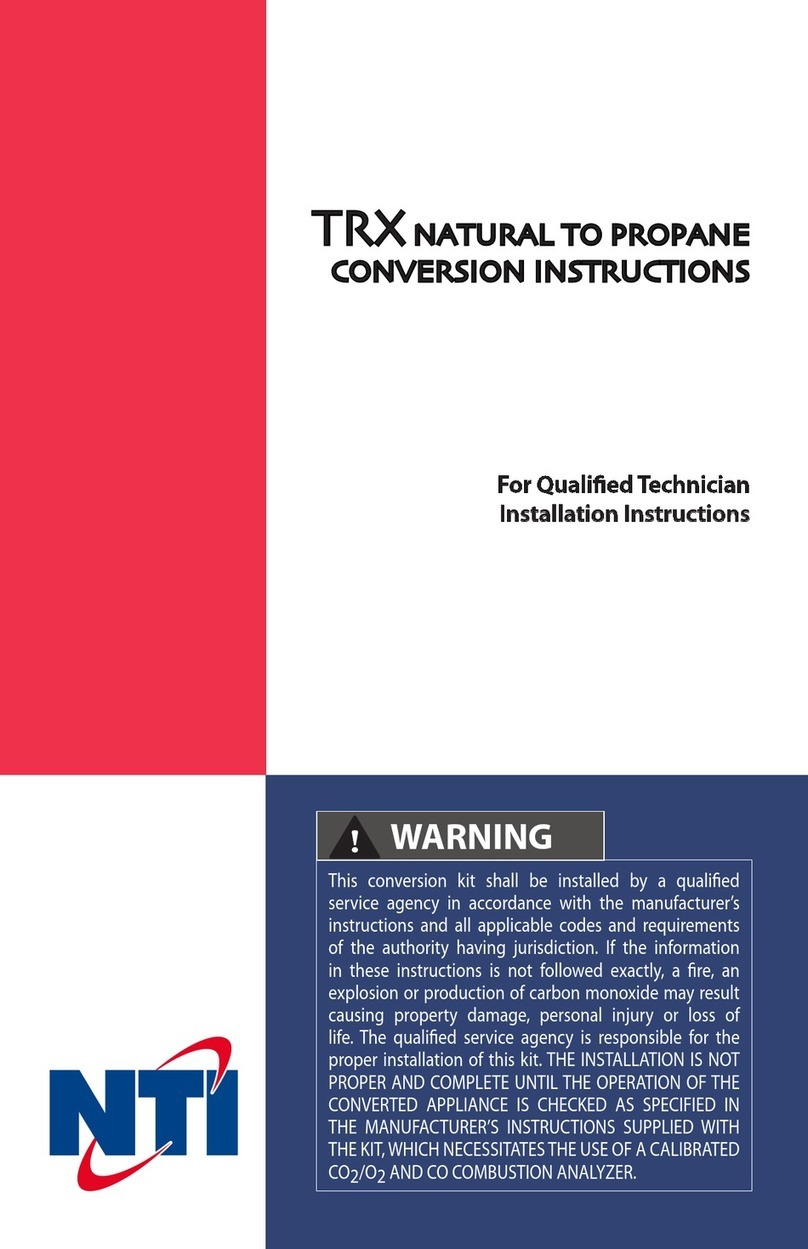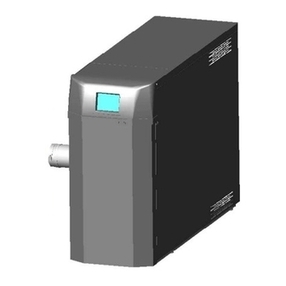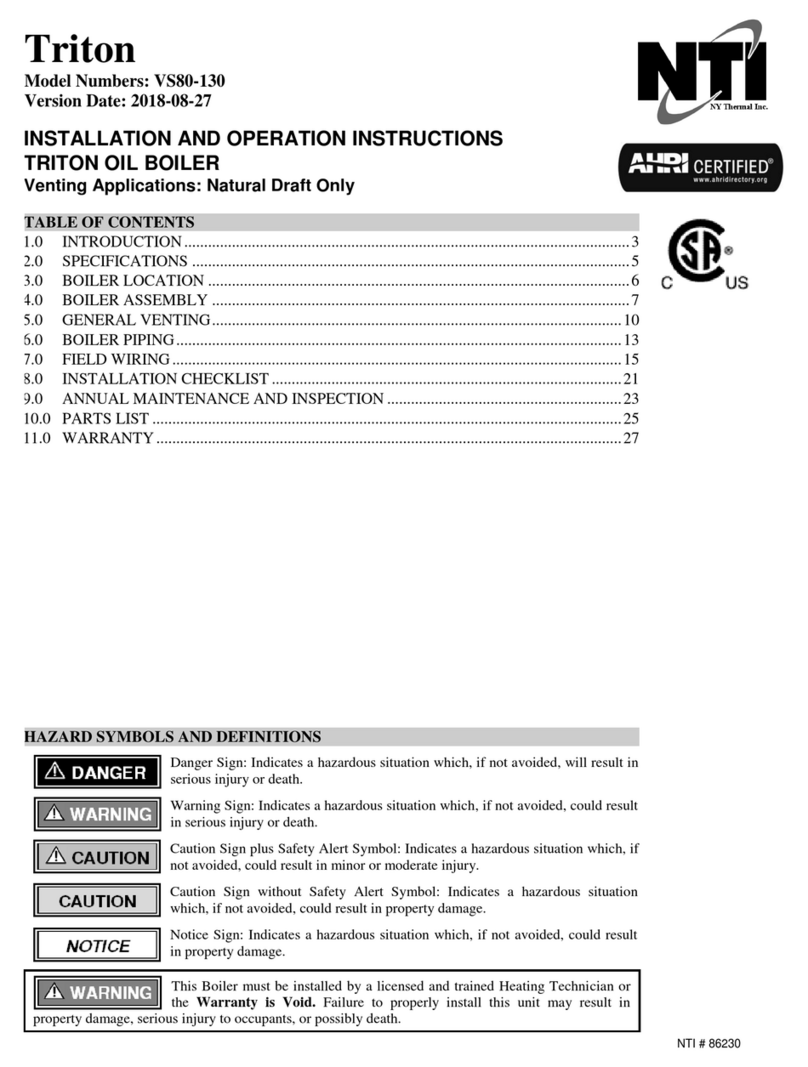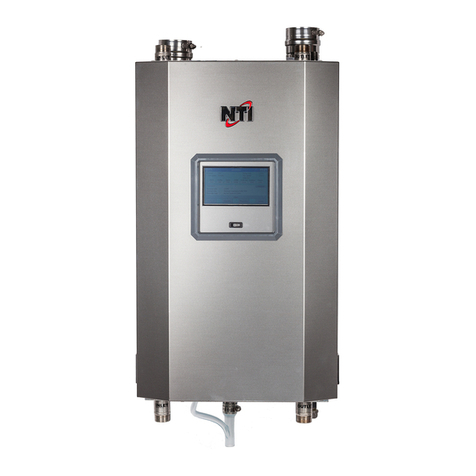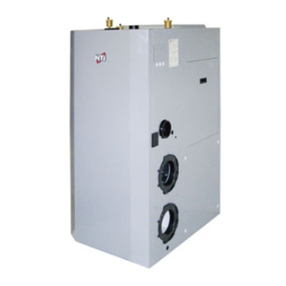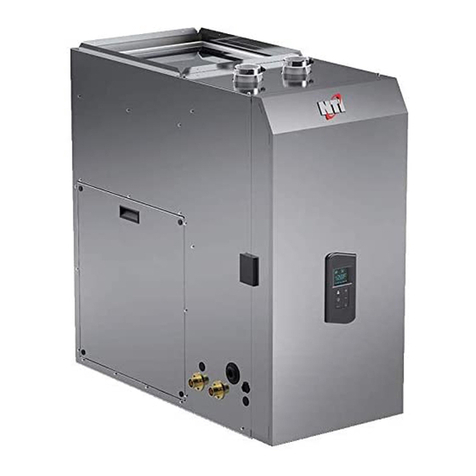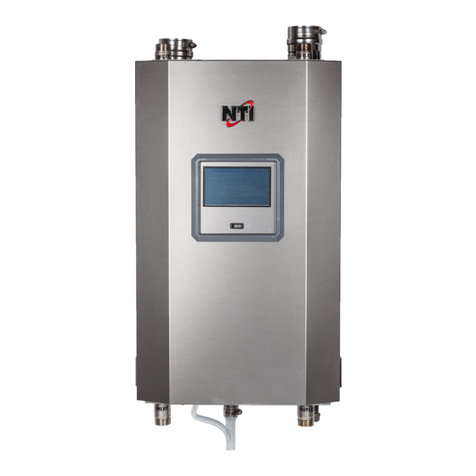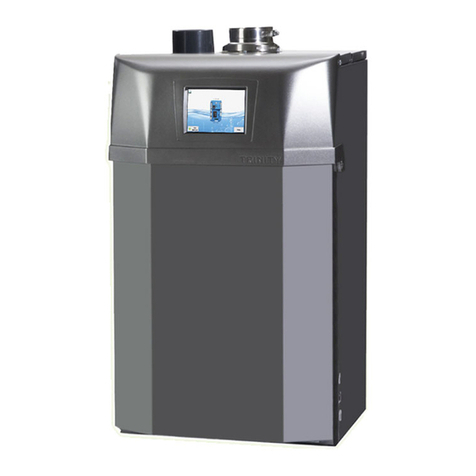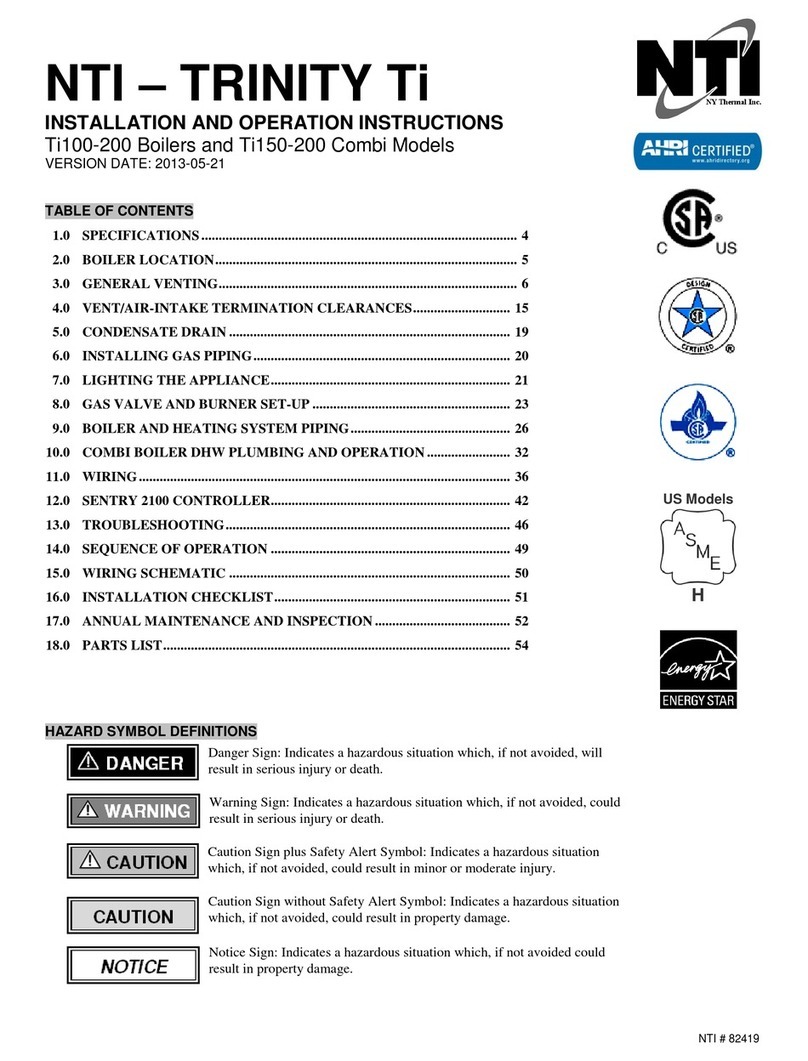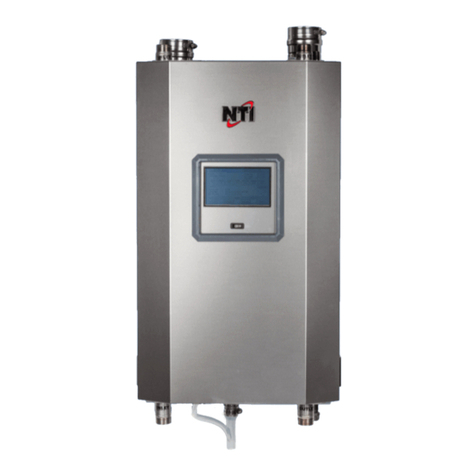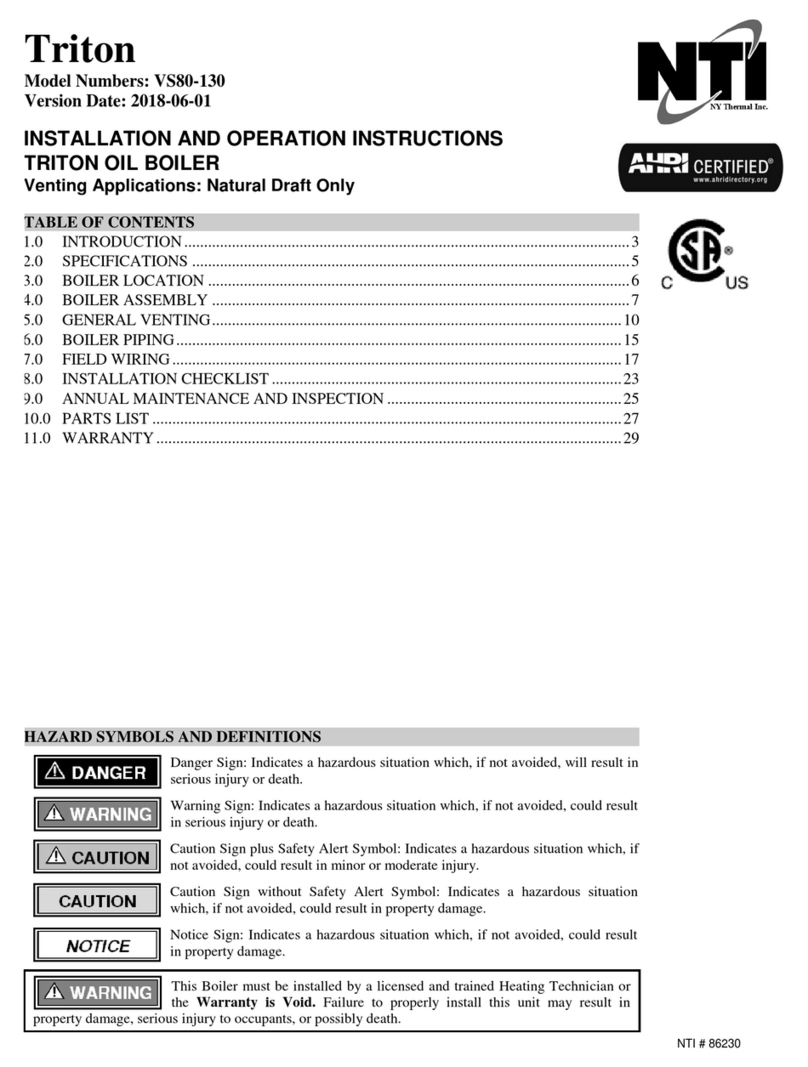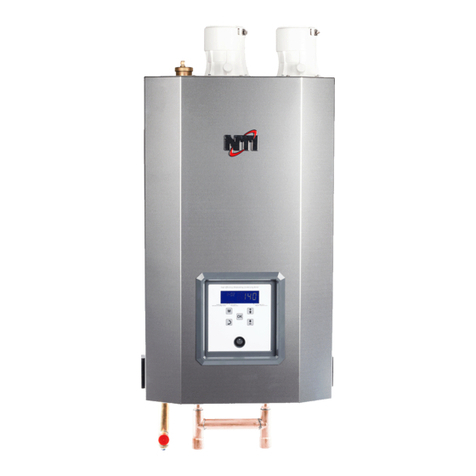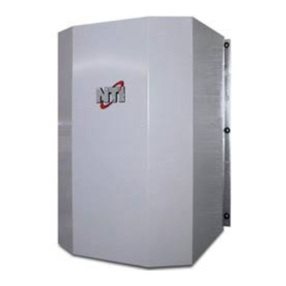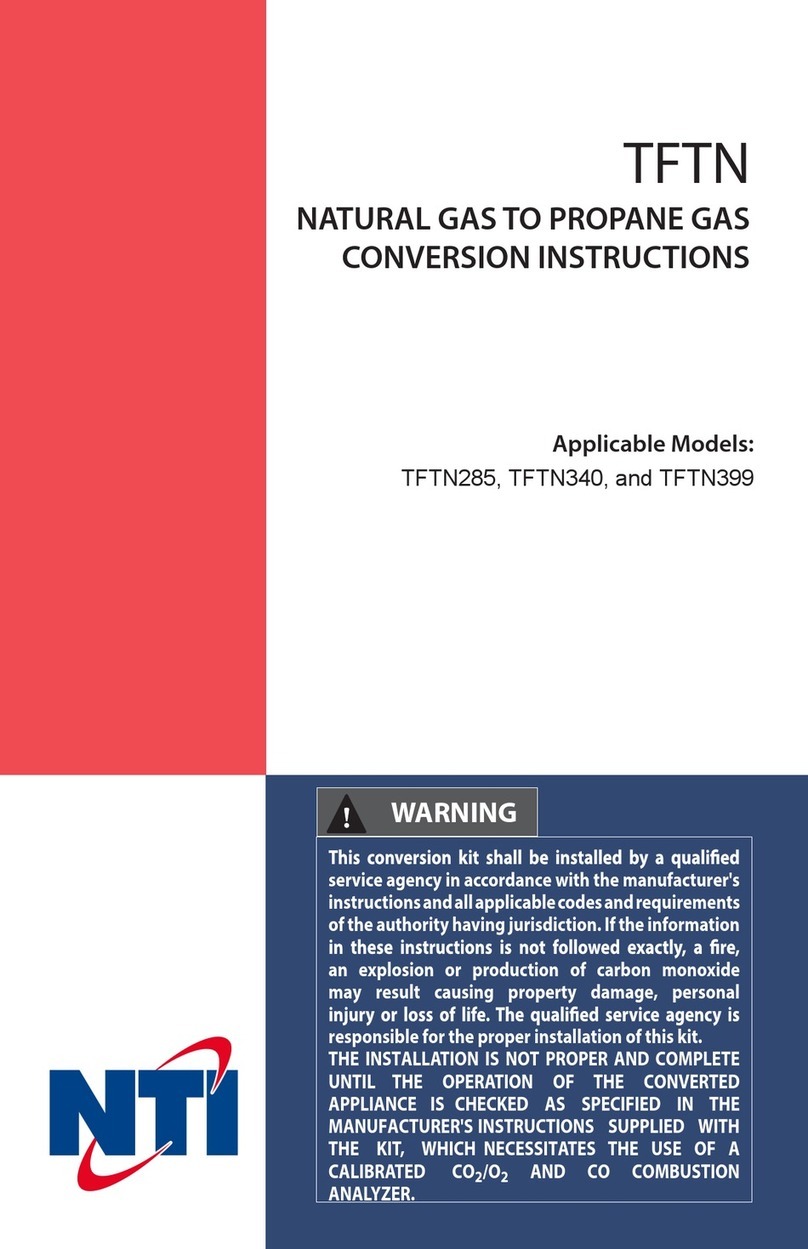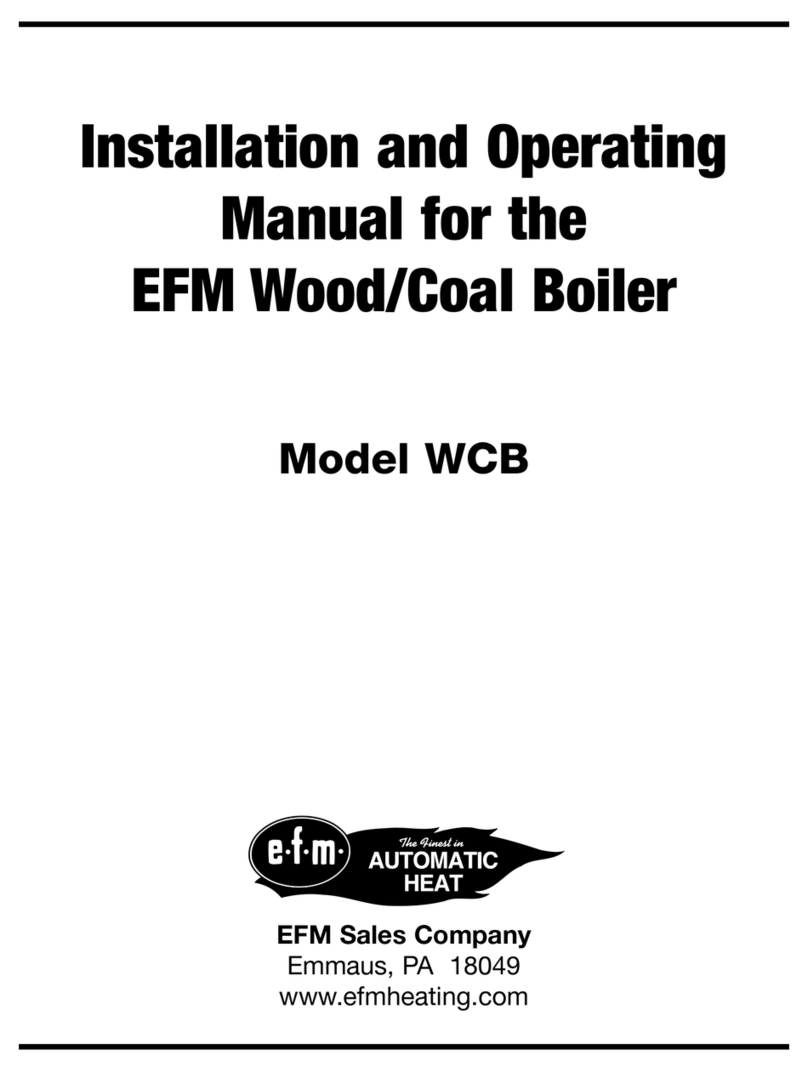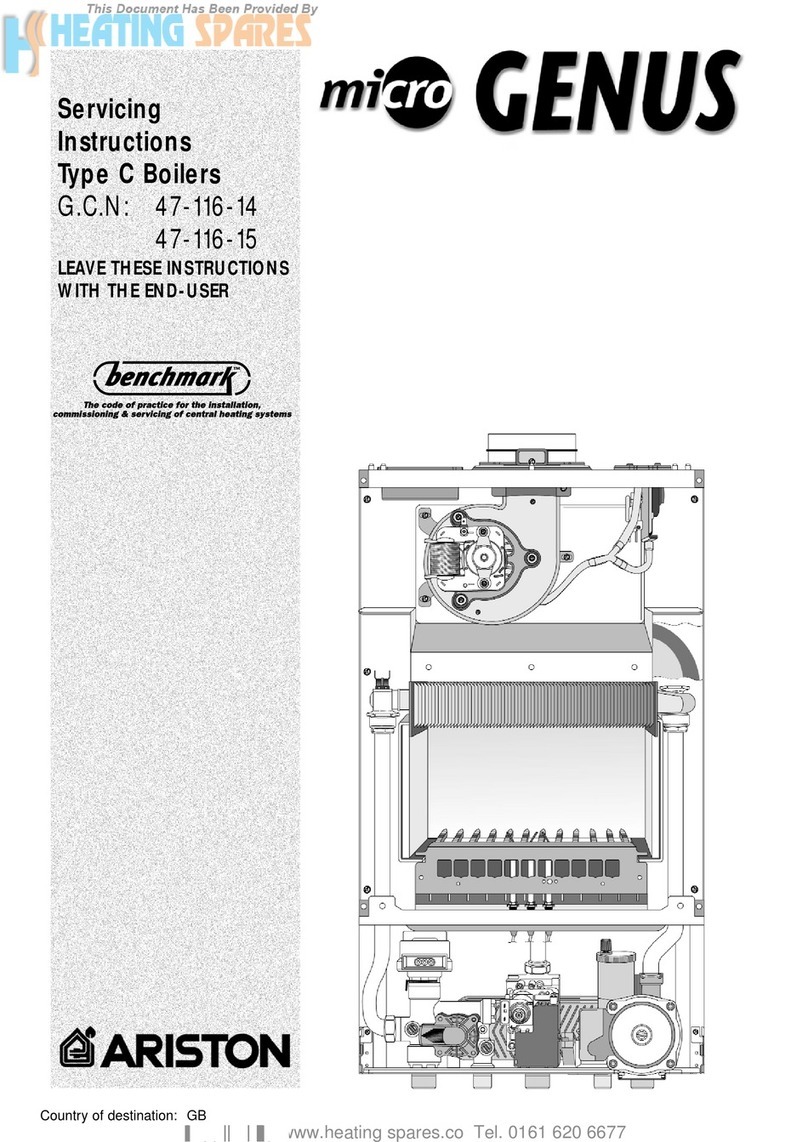NTI FTVN085 Installation manual

FTVNFTVN
Residential Condensing Gas Boiler
Installation
Start-Up
Maintenance
THIS MANUAL MUST ONLY BE USED BY A QUALIFIED INSTALLER / SERVICE
TECHNICIAN. READ ALL INSTRUCTIONS IN THIS MANUAL BEFORE
INSTALLING. PERFORM STEPS IN THE GIVEN ORDER. FAILURE TO DO SO
COULD RESULT IN SUBSTANTIAL PROPERTY DAMAGE, SEVERE PERSONAL
INJURY, OR DEATH.
Improper installation, adjustment, alteration, service, or maintenance could
void product warranty and cause property damage, severe personal injury,
or death.
California Proposition 65 Warning: This product contains chemicals known
to the State of California to cause cancer, birth defects, or other reproductive
harm.
The manufacturer reserves the right to make product changes or updates
without notice and will not be held liable for typographical errors in literature.
The surfaces of these products contacted by potable (consumable) water
contain less than 0.25% lead by weight as required by the Safe Drinking Water
Act, Section 1417.
WARNING
Heat Exchanger Bears the ASME “H” Stamp
DANGER
NOTICE
87030 Revision Date 5.14.21
FTVN085 / FTVN110
FTVN150 / FTVN199
FTVN110C / FTVN150C
FTVN199C Models

2
WARNING: If the information in these instructions is not followed exactly, a re or explosion may result causing property damage, personal
injury or death.
• Do not store or use gasoline or other ammable vapors and liquids in the vicinity of this or any other appliance.
WHAT TO DO IF YOU SMELL GAS
• Do not try to light any appliance.
• Do not touch any electrical switch; do not use any phone in your building.
• Immediately call your gas supplier from a neighbor’s phone. Follow the gas supplier’s instructions.
• If you cannot reach your gas supplier, call the re department.
• Installation and service must be provided by a qualied installer, service agency or the gas supplier.
Improper installation, adjustment, alteration, service, or maintenance can cause injury, property damage, or death. Refer to this manual.
Installation and service must be performed by a qualied installer, service agency, or gas supplier.
WARNING

3
Foreword
This manual is intended to be used in conjunction with other literature
provided with the boiler. This includes all related control information.
It is important that this manual, all other documents included in this
system, and additional publications including the National Fuel Gas
Code - ANSI Z223.1 in the United States and the Natural Gas and Propane
Installation Code - B149.1 in Canada (latest versions), be reviewed in
their entirety before beginning any work.
For the Installer
This boiler must be installed by qualied and licensed personnel. The
installer should be guided by the instructions furnished with the boiler,
and by local codes and utility company requirements. In the absence
of local codes, preference should be given to the National Fuel Gas
Code - ANSI Z223.1 in the United States and the Natural Gas and Propane
Installation Code - B149.1 in Canada (latest versions).
Installations Must Comply With:
Local, state, provincial, and national codes, laws, regulations, and
ordinances.
In the United States - The latest version of the National Fuel Gas Code,
ANSI Z223.1, from American Gas Association Laboratories, 8501 East
Pleasant Valley Road, Cleveland, OH 44131.
The latest version of the National Electrical Code, NFPA No. 70.
In Canada - The latest versions of the Natural Gas and Propane
Installation Code, CSA B149.1, and the Canadian Electrical Code, C22.1,
from CSA Group, 178 Rexdale Blvd, Toronto, Ontario, Canada M9W 1R3.
NOTE: The gas manifold and controls met safe lighting and other
performance criteria when undergoing tests specied in ANSI Z21.13
- latest edition.
Installation should be made in accordance with the regulations of
the Authority Having Jurisdiction, local code authorities, and utility
companies which pertain to this type of water heating equipment.
Authority Having Jurisdiction (AHJ) – The AHJ may be a federal, state,
provincial, local government, or individual such as a re chief, re
marshal, chief of a re prevention bureau, labor department or health
department, building ocial or electrical inspector, or others having
statutory authority. In some circumstances, the property owner or
his/her agent assumes the role, and at government installations, the
commanding ocer or departmental ocial may be the AHJ.
NOTE: The manufacturer reserves the right to modify product technical
specications and components without prior notice.
CAUTION
CAUTION
NOTICE
WARNING
The following dened terms are used throughout this
manual to bring attention to the presence of hazards of
various risk levels or to important product information.
DANGER indicates an imminently hazardous situation which,
if not avoided, will result in serious personal injury or death.
WARNING indicates a potentially hazardous situation which, if
not avoided, could result in personal injury or death.
CAUTION indicates a potentially hazardous situation which, if
not avoided, may result in moderate or minor personal injury.
CAUTION used without the safety alert symbol indicates a
potentially hazardous situation which, if not avoided, may
result in property damage.
NOTICE is used to address practices not related to personal
injury.
SPECIAL ATTENTION BOXES
DANGER

4
The hydronic supply and return connections of these products
are for installation in closed loop systems ONLY! Use of this
product in any manner other than described in this manual may
result in premature product failure, substantial property damage,
severe personal injury, or death. Damage or failure of this product
(or the system in which it is installed) due to unauthorized use IS
NOT COVERED BY WARRANTY.
IMPORTANT
In accordance with Section 325 (f) (3) of the Energy Policy and
Conservation Act, NTI has provided this boiler with multiple
features designed to save energy by reducing the boiler water
temperature as heating load decreases.
These features include:
• A modulating combustion system that adjusts ring
rate based on heat demand.
• Adjustment of boiler set point based on inferred heat
load as determined by an outdoor sensor. The outdoor
sensor is supplied with this boiler.
• This boiler does not include a standing pilot.
• This boiler is designed and shipped to assure the highest
eciency operation possible. Such high eciency is
achieved by limiting heating circuit water temperature
to 140°F when there is no anticipated heat load, based
upon the outdoor sensor and the Outdoor Reset Curve
(sensor response curve) in the boiler software.
• This feature may be over-ridden as described below in
specic installations:
• The boiler control is equipped with an outdoor sensor
override for use with building management systems
or in cascaded systems (for systems with total input of
300,000 BTU/hr or greater).
See statement below for an important notice on the use of the
override.
IMPORTANT
In accordance with Section 325 (f) (3) of the Energy Policy
and Conservation Act, this boiler is equipped with a feature
that saves energy by reducing the boiler water temperature
as the heating load decreases. This feature is equipped with
an override which is provided primarily to permit the use of
an external energy management system that serves the same
function. THIS OVERRIDE MUST NOT BE USED UNLESS AT
LEAST ONE OF THE FOLLOWING CONDITIONS IS TRUE:
• An external energy management system is installed that
reduces the boiler water temperature as the heating
load decreases.
• This boiler is not used for space heating.
• This boiler is part of a modular or multiple boiler system
having a total input of 300,000 BTU/hr or greater.
ASME CSD-1, Section CW-400 requires the temperature controls of
hot water heating boilers to
a) be accepted by a nationally recognized testing agency to
conform to UL 353,
b) shuto the fuel supply when the system water reaches a preset
operating temperature,
c) have a high temperature limit control that prevents the
water temperature from exceeding the maximum allowable
temperature by causing safety shutdown and lockout.
The temperature controls of this boiler have been accepted by a
nationally recognized testing agency to conform to UL 353; they
work to shuto the fuel supply when the system water temperature
reaches the preset operating temperature; and they cause a safety
shutdown and lockout, requiring a manual reset to start, when the
water temperature reaches 212°F.
WARNING
NOTICE
NOTICE
An ASSE 1017 or ASSE 1070 temperature limiting or mixing valve
is required in all combi boiler installations. Failure to install a
temperature limiting or mixing valve will result in property damage,
severe personal injury, or death due to scalds.
DANGER

5
Table of Contents
Part 1 - General Safety Information 6
A. Operation and Installation Warnings 6
B. Improper Combustion 7
C. Gas 7
D. When Servicing the Boiler 7
E. Boiler System 7
F. CH and DHW Loop Water Chemistry Requirements 8
G. Freeze Protection 8
H. Water Temperature Adjustment and Scalding 9
I. High Elevation Installations 9
Part 2 - Before You Start 10
A. What’s in the Box 10
B. Optional Equipment 11
Part 3 - Prepare the Boiler for Installation 12
A. Locating the Boiler 12
B. Leveling 13
C. Clearances for Service Access 13
D. Wall Mounting Considerations 14
E. Wall Mounting Instructions 14
1. Mounting to a Concrete Wall 14
2. Mounting to a Wood Studded Wall 14
F. Residential Garage and Closet Installations 14
G. Exhaust Vent and Intake Pipe 15
1. Direct Vent of Exhaust and Intake 15
2. Power Venting, Indoor Combustion Air in Conned or Unconned Space
15
H. Carbon Monoxide Detectors 15
I. Prevent Combustion Air Contamination 16
J. Removing a Boiler from a Common Vent System 16
K. Technical Specications 17
Part 4 - Water Piping 21
A. General Plumbing Information 21
B. Backow Preventer 21
C. Expansion Tank 21
D. Piping the Boiler 21
E. Internal Circulation Pump 23
F. CH and DHW Pressure Relief Valves 24
G. Air Elimination Device 25
H. Low Water Cut-O (Field Supplied) 25
I. Applications* 25
J. Floor Drying Function 33
Part 5 - Venting 34
A. General 34
B. Approved Materials for Exhaust Vent and Intake Pipe 35
C. Additional Requirements for Installation in Canada 35
D. Exhaust Vent and Intake Pipe Location 36
E. Exhaust Vent and Intake Pipe Sizing 37
F. Tightening Boiler Collar to Exhaust Vent and Intake Pipe 37
G. Exhaust Vent and Intake Pipe Installation 37
H. Applications 40
1. Direct Vent Installation of Exhaust and Intake 40
2. Venting Through an Existing System 46
3. Power Venting, Indoor Combustion Air in Conned or Unconned Space
47
Part 6 - Installing the Condensate Drain 48
Part 7 - Connecting Electrical Service 49
A. Wiring 49
1. Connecting Power (120V) for DHW and CH Circulators 49
2. Low Voltage Wiring Connections 49
3. Room Thermostat Wiring Connections 50
4. Outdoor Sensor Connections 50
5. Aquastat (Default) and Tank Sensor (Optional) Connections (non-Combi
Models) 50
B. Internal Wiring Details 51
Part 8 - Gas Connections 55
A. Gas Pipe Sizing Tables 55
1. Gas Pipe Sizing 55
2. Natural Gas Pipe Sizing 55
3. LP (Liquid Propane) Gas Pipe Sizing 55
B. Gas Connection Requirements 55
C. Additional Precaution for Excess Flow Valve (EFV) 56
D. Checking Gas Pressure at the Boiler for Proper Operation 56
Part 9 - Controls 57
A. Control and Display Overview 57
B. Ignition Procedure 58
C. Central Heating (CH) Temperature Adjustment 58
D.
Domestic Hot Water (DHW) Temperature Adjustment 58
E. User Menu 59
F. INFO Menu 60
G . Date and Time (If ITIME is set to OFF) 60
H. Automatic CH Temperature Control (AUTO) 61
I. Type of Temperature Control 62
J. Slope of Outdoor Reset Curve 62
K. Parallel Shift of Reset Curve 63
L. Auto Boost 63
M. Room Temperature Day /Night 64
N. Time Programs – Heating Schedule 64
O. Automatic Summer / Winter Changeover 64
P. Technical Menu - Access and Navigation 65
Q. Technical Menu - Menu Structure 66
R. Complete Menu Parameters 67
Part 10 - Start-Up Preparation 75
A. Check / Control Water Chemistry 75
B. Check for Gas Leaks 75
C. Freeze Protection (When Used) 75
D. System Water Fill, Purge, and Test 76
E. Purge Air from DHW System 76
F. Check Thermostat Circuit(s) 76
G. Condensate Removal 76
Part 11 - Start-Up 78
A. First Ignition 78
B. Combustion Checking Procedure 78
C. Checking Combustion Parameters 80
D. Converting the Appliance from Natural Gas to Propane Operation
80
Part 12 - Installation Checklist 81
Part 13 - Troubleshooting 83
A. Boiler Protection Devices 83
1. Blocking Error 83
2. Lockout Error 83
3. Malfunction Warning 83
B. Boiler Error Codes 84
Part 14 - Maintenance 88
A. Procedures 88
B. Maintenance That May be Performed by the User 88
C. Maintenance Only to be Performed by a Qualied Service
Technician 89
D. Replacing Components 92
E. After Maintenance is Complete 95
Part 15 - Maintenance Report 95
A. Shutdown Procedure 97
B. Failure to Operate 97
C. Important 97
Part 16 - Shutdown 97
Maintenance Notes 98
Customer Installation Record Form 99

6
Part 1 - General Safety Information
This boiler is approved for indoor installations only and is not intended
for use as a pool heater. Clearance to combustible materials: 0” top,
bottom, sides, and back. Boiler must have room for service: 18” front,
14” top, 12” bottom, 2” left and right sides and 0” back are minimum
recommended service clearances. (A combustible door or removable
panel is acceptable front clearance. A 3” minimum clearance must
be provided from the boiler front cover to the removable panel or
combustible door.)This boiler has been approved for closet installation
and installation on combustible ooring. Do not install directly on
carpeting. Install the boiler in a location where relief valve discharge
or a leak will not result in damage to the surrounding area. If such a
location is not available install an auxiliary catch pan.
This appliance is rated Category IV (pressurized vent, likely to form
condensate in the vent) and requires a special vent system designed
for pressurized venting. Use only Category IV vent systems.
Installer - Read all instructions in this manual before installing.
Perform steps in the given order.
User - This manual is for use only by a qualied service technician.
Have this boiler serviced / inspected annually by a qualied service
technician.
FAILURETO ADHERE TO THE GUIDELINES ON THIS PAGE CAN RESULT
IN SUBSTANTIAL PROPERTY DAMAGE, SEVERE PERSONAL INJURY,
OR DEATH.
NOTE: Obey all local codes. Obtain all applicable permits before
installing the boiler.
NOTE: Install all system components and piping in such a manner
that does not reduce the performance of any re rated assembly.
A. Operation and Installation Warnings
To avoid serious injury or death, read, understand, and follow all of the
precautions listed here.
Vapors from ammable liquids will explode and cause a re,
resulting in personal injury or death. The boiler has a burner that
can come on at any time and ignite vapors. DO NOT use or store
ammable liquids around the boiler.
Improper venting can cause a build-up of carbon monoxide.
Breathing carbon monoxide can result in brain damage or death.
DO NOT operate the boiler unless it is properly vented to the
outside and has an adequate fresh air supply for safe operation.
Inspect the exterior exhaust gas outlet port and fresh air inlet port
on a regular basis to ensure they are functioning properly.
A concentration of carbon monoxide as small as .04% (400 parts
per million) in the air can be fatal. When making high re or low
re adjustments, CO levels must be monitored using a calibrated
combustion analyzer such that a CO level of no more than 150
ppm is exceeded at any time during operation.
Adjusting the “low re offset” or the “main ow restrictor” in small
increments can result in a signicant increase in CO concentration.
To avoid serious injury or death, DO NOT make any adjustments to
the gas valve without monitoring the exhaust gases with a fully
functional and calibrated combustion analyzer.
Failure to follow these instructions will result in property damage,
severe personal injury, or death.
WARNING
WARNING
DANGER
NOTE: If the boiler is exposed to re or water (or is any way
damaged), do not operate. Immediately call a qualied service
technician. Failure to follow this information could result in property
damage, severe personal injury, or death.
This boiler must be installed by a qualied service technician.
Improper installation and/or operation can cause a potentially
hazardous situation, which if not avoided will void the warranty and
could result in serious injury or death.
The manufacturer cannot anticipate every circumstance that might
involve a potential hazard. Each installation has its own specialized
characteristics, requirements, and possible hazards. Therefore, all
possible incidents are not included in these warnings. Proper and
safe installation, operation, and service are the responsibility of
the qualied service technician.
Proper care of the boiler is the user’s responsibility. Ensure the
user carefully reads and understands the User’s Information
Manual before operating the boiler.
Make sure the user knows the location of the gas shut-off valve
and how to operate it. Immediately close the gas shut-off valve
if the appliance is subjected to re, overheating, ood, physical
damage, or any other damaging condition that might affect the
operation of the unit. Have the appliance checked by a qualied
service technician before resuming operation.
Do not power up the unit unless the gas and water supply valves
are fully opened. Make sure the fresh air intake port and exhaust
gas port are open and functional.
No one but a qualied service technician should attempt to install,
service, or repair this boiler. There are no serviceable parts which
can be changed by the user / owner.
User / Owner: Contact the original qualied service technician if
the boiler needs repair / maintenance. If the original technician
is unavailable, ask your gas supplier for a list of qualied service
providers.
DO NOT store or place newspapers, laundry, or other combustible
items near the appliance or the exterior exhaust gas outlet and/or
fresh air inlet port.
The owner should inspect the system monthly for damage, water
stains, signs of rust, corrosion, and exhaust vent and air intake
blockage. If inspection of the unit shows signs of damage, the
boiler should be shut off until the problem is repaired by a qualied
technician.
After installation, all appliance safety devices should be tested.
The boiler is certied for indoor installations only. The boiler
consists of gas ignition system components which must be
protected from water (dripping, spraying, etc.) during operation and
service. Carefully consider installation location and the placement
of critical components (circulators, condensate neutralizers, etc.)
before installing the boiler.
DO NOT allow children to operate this boiler. DO NOT use this boiler
if it does not appear to be operating correctly. A qualied service
technician should service and inspect the boiler annually.

7
Part 1 - General Safety Information
B. Improper Combustion
WARNING
WARNING
DO NOT USE THIS BOILER IF ANY PART HAS BEEN SUBMERGED IN
WATER. Immediately call a qualied service technician. The boiler
MUST BE replaced if it has been submerged. Attempting to operate
a boiler that has been submerged could create numerous harmful
conditions, such as a potential gas leakage causing a re and/
or explosion, or the release of mold, bacteria, or other harmful
particulates into the air. Operating a previously submerged boiler
could result in property damage, severe personal injury, or death.
NOTE: Boiler damage due to ood or submersion is considered an
Act of God, and IS NOT covered under product warranty.
DO NOT alter or modify the appliance or appliance controls.
Altering any NTI boiler with parts not manufactured by NTI WILL
INSTANTLY VOID the boiler warranty and could result in property
damage, personal injury, or death.
This appliance is equipped with a three prong plug. It should only be
plugged directly into a properly grounded three prong receptacle.
DO NOT remove the ground plug from the plug.
This appliance provides an overheat shutdown limit. In the event the
appliance water temperature exceeds the setpoint of the control
limit, the cutoff will trip and the appliance will shut down. Certain
local codes require additional temperature limits. In addition,
certain types of systems may operate at temperatures below the
minimum setpoint of the limit provided with the appliance. Contact
the manufacturer for additional overheat controls.
Do not use this boiler for anything other than its intended purpose
(as described in this manual). Doing so could result in property
damage and WILL VOID product warranty.
Do not obstruct the ow of combustion and ventilating air.
Adequate air is necessary for safe operation. Failure to keep the
exhaust vent and combustion air intake clear of ice, snow, or other
debris could result in property damage, serious personal injury, or
death.
C. Gas
Should overheating occur or gas supply fail to shut o, turn o the
manual gas control valve to the boiler.
D. When Servicing the Boiler
• To avoid electric shock, disconnect electrical supply before
performing maintenance.
• To avoid severe burns, allow boiler and associated equipment
to cool before servicing.
Be sure to disconnect electrical power before opening boiler
cabinet or performing service. Label all wires while performing
service to ensure proper re-wiring of the appliance. Wiring errors
can cause improper or dangerous operation. Failure to do so could
result in electrical shock, improper boiler or system operation,
property damage, serious personal injury, or death.
Due to the low water content of the boiler, improper sizing of the
boiler with regard to heating system load will result in excessive
cycling and accelerated component failure. DO NOT under or
oversize the boiler to the system. Modular boiler installations
greatly reduce the likelihood of boiler oversizing. NTI DOES NOT
warrant failures caused by improperly sized boiler applications.
High heat sources (sources generating heat 100oF / 37oC or
greater, such as stove pipes, space heaters, etc.) may damage
plastic components of the boiler as well as plastic vent pipe
materials. Such damages ARE NOT covered by warranty. It is
recommended to keep a minimum clearance of 8” from high heat
sources. Observe heat source manufacturer instructions, as well
as local, state, provincial, and national codes, laws, regulations
and ordinances when installing this boiler and related components
near high heat sources.
CAUTION
NOTICE
WARNING
WARNING
E. Boiler System
• Thoroughly ush the system (without the boiler connected)
to remove sediment. The high-eciency heat exchanger can
be damaged by build-up or corrosion due to sediment. The
manufacturer recommends a suction strainer in this type of
system.
• Do not use petroleum-based cleaning or sealing compounds
in boiler system. Gaskets and seals in the system may be
damaged, possibly resulting in substantial property damage.
• Do not use “homemade cures” or “boiler patent medicines”.
Substantial property damage, damage to the boiler, and/or
serious personal injury may result.
• Continual fresh make-up water will reduce boiler life. Mineral
buildup in the heat exchanger reduces heat transfer, overheats
the stainless steel heat exchanger, and causes failure. Addition
of oxygen from make-up water can cause internal corrosion
in system components. Leaks in the boiler or piping must be
repaired at once.
NOTE: DO NOT add cold make up water to the system when the
boiler is hot. Thermal shock can potentially cause cracks in the heat
exchanger. Such damage IS NOT covered by warranty.
• Do not use petroleum-based cleaning or sealing compounds
in boiler system. Gaskets and seals in the system may be
damaged, possibly resulting in substantial property damage.
• Do not use “homemade cures” or “boiler patent medicines”.
Substantial property damage, damage to boiler, and/or serious
personal injury may result.
• Always verify proper operation after servicing the boiler.
NOTE: When inquiring about service or troubleshooting, reference the
model and serial numbers from the boiler rating label.

8
Part 1 - General Safety Information
F. CH and DHW Loop Water Chemistry Requirements
The water must be potable, free of corrosive chemicals, sand,
dirt, and other contaminates. It is up to the installer to ensure the
water does not contain corrosive chemicals or elements that can
damage the heat exchanger. Potable water is dened as drinkable
water supplied from utility or well water in compliance with EPA
secondary maximum contaminant levels (40 CFR Part 143.3). If
the water contains contaminants higher than outlined by the EPA,
water treatment is recommended and additional, more frequent
maintenance may be required. See Table 1.
If you suspect that your water is contaminated in any way,
discontinue use of the appliance and contact an authorized
technician or licensed professional.
Chemical imbalance of the water supply may affect efciency and
cause severe damage to the boiler and associated equipment.
Water quality must be professionally analyzed to determine
whether it is necessary to treat the water. Various solutions are
available to adjust water quality. Adverse water quality will affect
the reliability of the system. In addition, operating temperatures
above 135oF will accelerate the build-up of lime scale and possibly
shorten boiler service life. Failure of a boiler due to lime scale
build-up, low pH, or other chemical imbalance IS NOT covered by
the warranty.
CAUTION
CAUTION
CH Loop Total Water Hardness Specications
Contaminant Maximum Allowable Level
Total Hardness 120 mg/l
(7 grains/gallon)
DHW Loop Total Water Hardness Specications
Contaminant Maximum Allowable Level
Total Hardness
(Below 140oF water temperature)
200 mg/l
(12 grains/gallon)
Total Hardness
(Above 140oF water temperature)
120 mg/l
(7 grains/gallon)
CH and DHW Loop Water Quality Specications
Contaminant Maximum Allowable Level
Aluminum 0.05 to 0.2 mg/l or PPM
Chloride 100 mg/l or PPM
Copper 1 mg/l or PPM
Iron 0.3 mg/l or PPM
Manganese 0.05 mg/l or PPM
pH 6.5 - 8.5
Sulfate 205 mg/l or PPM
Total Dissolved Solids (TDS) 500 mg/l or PPM
Zinc 5 mg/l or PPM
Dissolved Carbon Dioxide (CO2) 15 mg/l or PPM
Table 1 - Water Quality Specications
G. Freeze Protection
NEVER use any toxic chemical, including automotive, standard
glycol antifreeze, or ethylene glycol made for hydronic (non-
potable) systems. These chemicals can attack gaskets and seals in
water systems, are poisonous if consumed, and can cause personal
injury or death.
Consider piping and installation when determining boiler location.
Damages resulting from incorrect installation or from use of
products not approved by the manufacturer ARE NOT covered by
warranty. Failure of the boiler due to freeze related damage IS NOT
covered by product warranty.
NOTE: Loops Serving Indirect Water Heaters (IWHs)
Glycol used in IWH loops should be food grade propylene glycol,
FDA rated as “generally recognized as safe” (GRAS). If using a glycol /
potable water mix, the water chemistry must meet the requirements
in this manual. The glycol content of the liquid must not exceed 50%,
unless the manufacturer species a dierent ratio. Glycol should be
checked periodically to prevent it from becoming acidic. Please refer
to guidelines provided by the glycol manufacturer regarding glycol
maintenance.
NOTE: Glycol not recognized as GRAS may only be used in closed loop
CH applications.
NOTE: NTI DOES NOTWARRANTTHE BOILER AGAINST FREEZE-RELATED
DAMAGE.
The boiler control is equipped with freeze protection that activates
based on internal water temperature. See the following table for
details on freeze protection operation.
NOTE: Freeze protection will not be active if the boiler loses power.
WARNING
FREEZE PROTECTION OPERATION
STAGE 1
Condition The water temperature detected by probes NTC1 or
NTC2 ranges between 39oF (4oC) and 46oF (8oC).
Events
• The internal pump operates at high speed.
• The 3-Way Valve alternately switches positions - 1
minute on heating mode to 1 minute on DHW
mode
• The display shows the icon.
Time Until the NTC1 and NTC2 temperature is greater than or
equal to 46°F (8°C)
If after 20 minutes the conditions described in Stage 1
are still present, the boiler proceeds to Stage 2.
STAGE 2
Condition The water temperature detected by probes NTC1 or
NTC2 is less than 39oF (4oC).
Events
• The burner turns on at minimum power.
• The 3-Way Valve is positioned on DHW and
switches every 30 seconds between CH and DHW.
• When the temperature is greater than or equal to
104oF (40oC) the burner will turn o. The boiler will
maintain the temperature between 95oF (35oC)
and 104oF (40oC) for 45 minutes.
• After 45 minutes there will be 2 minutes of post
heating circulation.
• If the temperature falls below 46oF (8oC) within
150 minutes the burner will immediately power on
again.
• The display shows the icon.
Time Until the NTC1 temperature is greater than or equal to
104oF (40oC)
Table 2 - Freeze Protection Detail

9
Part 1 - General Safety Information
CAUTION
I. High Elevation Installations
H. Water Temperature Adjustment and Scalding
This boiler can deliver scalding water. Be careful whenever using hot
water to avoid scalding injury. Certain appliances such as dishwashers
and automatic clothes washers may require increased water
temperatures. By setting the thermostat on this boiler to obtain the
increased water temperature required by these appliances you may
create the potential for scald injury.
To protect against injury, install a mixing valve in the water system.This
valve will reduce point of use discharge temperatures by mixing cold
and hot water in branch supply lines. Such valves are available from
your local plumbing supplier.
Table 3 details the relationship of water temperature and time with
regard to scald injury and may be used as a guide in determining the
safest water temperature for your applications.
On FTVN085 / FTVN110 / FTVN150 / FTVN199 Models ONLY
If the boiler is to be used only in Heating Mode (not connected to
an indirect water heater), the electrical connection of the 3-way
valve motor MUST BE DISCONNECTED while the boiler is operating
in central heating mode. This will lock the valve motor in central
heating mode and ensure freeze protection operates properly.
Failure to disconnect the valve may disable boiler freeze protection
and result in property damage.
Approximate Time / Temperature Relationships in Scalds
120oF More than 5 minutes
125oF 1 1/2 to 2 minutes
130oF About 30 seconds
135oF About 10 seconds
140oF Less than 5 seconds
145oF Less than 3 seconds
150oF About 1 1/2 seconds
155oF About 1 second
Table 3 - Time and Temperature Relationship in Scalds
An ASSE 1017 or ASSE 1070 temperature limiting or mixing valve
is required in all combi boiler installations. Failure to install a
temperature limiting or mixing valve will result in property damage,
severe personal injury, or death due to scalds.
DANGER
WARNING
Combustion - At elevations above 2000 ft, the combustion
of the boiler must be checked with a calibrated combustion
analyzer to ensure safe and reliable operation. It is the Installer’s
responsibility to check and adjust the combustion in
accordance with this manual. Failure to follow these instructions
may result in property damage, serious personal injury, or death.
This boiler is designed to operate at its maximum listed capacity in
installations located at 0 - 2000 ft above Sea Level. Since the density
of air decreases as elevation increases, maximum specied capacity
should be de-rated for elevations above 2000 ft (610 m) in accordance
with the table below.
Elevations 2001 ft
(610 m)
3000 ft
(914 m)
4000 ft
(1219 m)
4500 ft
(1372 m)
5000 ft
(1524 m)
In Canada1,
de-rate by: 10% 10% 10% 10% may vary
In USA2,
de-rate by: - 12% 16% 18% 20%
NOTES:
1Canada: Elevations between 2000 - 4500 ft (610 - 1372 m), de-rate by 10%.
Consult local authorities for de-rating for elevations above 4500 ft (1372 m).
2USA: If elevation is above 2000 ft (610 m), de-rate capacity by 4% for every
1000 ft (305 m).
Table 4 - De-Rate % for High Elevations
The use of glycol may reduce the usable BTU output of the boiler,
requiring the unit to be “down-red” by limiting the maximum
operating capacity and/or water temperature. For applications
requiring glycol concentrations greater than 30%, such as snow
melt systems, it is recommended to use a brazed plate heat
exchanger to separate the glycol mixture from the boiler water. See
below.
NOTICE
Figure 1 - Snow Melt Application

10
Part 2 - Before You Start
Included components:
A. What’s in the Box
UNCRATING THE BOILER - Any claims for damage or shortage in
shipment must be led immediately against the transportation
company by the consignee.
Remove the boiler from the packaging. Remove the accessory box
from the boiler. Take care to place the boiler in a safe location prior to
installation to prevent damage to the mechanical connections.
Figure 2 - Included with the Boiler
NOTICE
How the Boiler Operates
FTVN condensing technology intelligently delivers hydronic heating
while maximizing eciency. Outlined below are system features and
operation:
Stainless Steel Heat Exchanger
The highly ecient stainless steel heat exchanger is designed to
extract all available heat from the supply line before it is exhausted.
Modulating Combustion System
The combustion system modulates the output of the burner during
operation to match system demand and achieve the control set point
while in operation. The set point can change by internal or external
signals to enhance the overall performance of the system.
Control
The integrated control system monitors the system and regulates fan
speed to control boiler output. This allows the boiler to deliver only the
amount of heat energy required and nothing more.
The control can be set to monitor outdoor temperature through an
outdoor sensor to regulate boiler set point. The system can be further
enhanced by installing an indirect water heater to provide domestic
hot water.
The control can regulate the output of multiple boilers through its
cascade system function. The cascade system is capable of connecting
up to eight boilers together in such a way that they function as one
boiler system. This allows for greater turn down ratios and provides
systematic control of the multiple boilers in an installation to minimize
downtime and maximize eciency.
The cascade system works by establishing one boiler as the master and
the other connected boilers as followers. The master boiler requires
a sensor to provide feedback on set point temperature in order to
adjust heating input from the connected boilers. Each cascaded boiler
will have its own pump to provide maximum ow and control heat
exchanger ow rate.
Text Display and Operational Display Icons
The display allows the user to change system parameters and monitor
system outputs.
Gas Valve
Senses suction from the blower, allowing gas to ow only if powered
and combustion air is owing.
Integrated Venturi
Controls air and gas ow into the burner.
Burner
The high grade stainless steel burner uses premixed air and gas to
provide a wide range of ring rates.
Spark Ignition
The burner is ignited by applying high voltage through the system
spark electrode. The spark from the electrode ignites mixed gas o of
the burner.
Supply Water Temperature Sensor
This sensor monitors the boiler outlet water temperature (System
Supply). The control adjusts boiler ring rate so the supply temperature
will match the boiler set point.
Return Water Temperature Sensor
This sensor monitors boiler return water temperature (System Return).
Flue Sensor
Monitors ue temperature and adjusts ring rate.
Temperature and Pressure Gauge
Allows the user to monitor system temperature and pressure.
Electrical eld connections with terminal strips
The electrical cover allows easy access to the clearly marked line
voltage and low voltage terminal strips to facilitate wiring the boiler.
Condensate Collection System
This boiler is a high eciency appliance and will produce condensate.
The condensate collection system has a oat switch which monitors
condensate level and prevents condensate from backing up into
the combustion system. Inside the collection system is a built in trap
which seals the combustion system from the connected drain. This
Nr. Quantity Description
1 1 Condensing Gas Boiler
2 1 Condensate Drain Pipe
3 1 Upper Bracket
4 2 Assembly Screws (Fischer Type SX )
5 1 CH Pressure Relief Valve
6 1 3” CPVC Pipe, 5” Long
7 2 + 2 2”Vent Screen + 3”Vent Screen (3”Only - 199 Models)
8 1 Tridicator
9 1 Lower Bracket
10
1 Installation Manual (This Document)
1 User’s Information Manual
1 Connectivity Quick Start Guide
1 LP Conversion Instructions
1 Warranty
1 Programming Guide
11 1 LP Gas Conversion Kit
12 1 Outdoor sensor Kit
13 1 3/4” Cap (Not Included with Combis, and not shown)
TRX085
All models
TEMPLATE
QSG
THISCONTROL WASCONVERTED FOR USE WITH PROPANE GAS
Thisappliance has been converted for use with PropaneGas, in accordance with the
instructionsprovided with the Natural to Propane ConversionKit
by______________________________________ , which accepts responsibility that
theconversion was performed properly.
Referenceratingplate for Propane Input and Gas Pressure
420060882600
20
0 250
100 150
50 200
20
080
60
40
psi
TRX110C
1
2
3
12
13
14 15
4
55
6
7
8
9
10
11
TRX
TRX
Residential Condensing Gas Boiler
User’s
Information
Manual
User Operating
Instructions
IF THE INFORMATION IN THIS MANUAL IS NOT FOLLOWED EXACTLY,
A FIRE OR EXPLOSION MAY RESULT,CAUSING PROPERTY DAMAGE,
PERSONAL INJURY, OR LOSS OF LIFE. DO NOT STORE GASOLINE OR
OTHER FLAMMABLE VAPORSAND LIQUIDS IN THE VICINITY OF THIS OR
ANY OTHER BOILER.
WHAT TO DO IF YOUSMELL GAS
• Do not try to light any boiler.
• Do not touch any electrical switch.
• Do not use any phone in your building.
• Immediatelycall your gas supplier from a neighbor’s phone. Follow the
gas supplier’sinstructions.
• If you cannot reach your gas supplier, call the fire department.
Installation and service must be provided by a qualified installer,
service agency,or the gas supplier.
Improperinstallation, adjustment, alteration, service, or maintenance could
void product warranty and cause property damage, severe personal injury,
or death.
California Proposition 65 Warning: This product contains chemicals
known to the State of California to cause cancer, birth defects, or other
reproductive harm.
The manufacturer reserves the right
to make product changes or updates
without notice and will not be held
liable for typographical errors in
literature.
The surfaces of these products
contacted by potable (consumable)
water contain less than 0.25% lead by
weightas required by the Safe Drinking
WaterAct, Section 1417.
NOTE TO CONSUMER:
PLEASE KEEP ALL INSTRUCTIONS
FOR FUTURE REFERENCE.
WARNING
NOTICE
HeatExchanger Bears the ASME “H”Stamp
TRX
TRX
Residential Condensing Gas Boiler
Installation
Start-Up
Maintenance
Parts
Warranty
THIS MANUAL MUST ONLY BE USED BY A QUALIFIED INSTALLER /
SERVICE TECHNICIAN. READ ALL INSTRUCTIONS IN THIS MANUAL
BEFORE INSTALLING. PERFORM STEPS IN THE GIVEN ORDER. FAILURE
TODO SO COULD RESULT IN SUBSTANTIAL PROPERTY DAMAGE,SEVERE
PERSONAL INJURY,OR DEATH.
Improper installation, adjustment, alteration, service, or maintenance
could void product warranty and cause property damage, severe
personal injury,or death.
California Proposition 65 Warning: This product contains chemicals
known to the State of California to cause cancer, birth defects, or
other reproductive harm.
The manufacturer reserves the right to make product changes or updates
without notice and will not be held liable for typographical errors in literature.
The surfaces of these products contacted by potable (consumable) water
contain less than 0.25% lead by weight as required bythe Safe Drinking Water
Act, Section 1417.
WARNING
HeatExchanger Bears the ASME “H”Stamp
DANGER
NOTICE
Connectivity
Quick Start Guide
TRX series
ForQualified Technician
Installation Instructions
TRX NATURAL TO PROPANE
CONVERSION INSTRUCTIONS
This conversion kit shall be installed by a qualified
service agency in accordance with the manufacturer’s
instructions and all applicable codes and requirements
of the authority having jurisdiction. If the information
in these instructions is not followed exactly, a fire, an
explosion or production of carbon monoxide may result
causing property damage, personal injury or loss of
life. The qualified service agency is responsible for the
proper installation of this kit. THE INSTALLATIONIS NOT
PROPER AND COMPLETE UNTIL THE OPERATIONOF THE
CONVERTED APPLIANCE IS CHECKED AS SPECIFIED IN
THE MANUFACTURER’S INSTRUCTIONS SUPPLIED WITH
THEKIT, WHICH NECESSITATESTHE USE OF A CALIBRATED
CO2/O2ANDCO COMBUSTION ANALYZER.
WARNING
Gas
Gas
14a
15a
14f
14e
14h 15g
14b
14c
14d
14g
15b
15c
15d
15e
15f
ACCESSORIES BOX
BOITE ACCESSOIRES
ForQualified Technician
InstallationInstructions
Pourtechnicien qualifié
instructionsd’installation
Readthe code
Lirele code
code
ACCESSORIES BOX
BOITE ACCESSOIRES
ForQualified Technician
InstallationInstructions
Pourtechnicien qualifié
instructionsd’installation
Readthe code
Lirele code
code
11 12
9
8
7
65

11
Part 2 - Before You Start
condensate should be neutralized to avoid damage to the drainage
system or piping.
Outdoor Sensor
Monitors outdoor temperature and adjusts unit set point to provide
greater eciency.
0-10 Volt Input / 4-20 mA Input (with Optional Analog Clip-In
Board, part # 3319457)
Allows the installer to connect a BMS (Building Management System)
to control the boiler.
Condensate Trap
The condensate trap prevents condensate and heat exchanger exhaust
from backing up into the boiler.
Pump Service Mode
Allows manual operation of pumps to commission system and check
pump operation.
Internal By-Pass Valve
Protects the boiler from damage in low ow conditions.
Internal ECM Pump
The internal ECM Pump uses less electricity than standard pumps,
providing high performance operation.
DHW Temperature Sensor
Monitors DHW outlet temperature. The control adjusts boiler ring rate
to match the DHW supply temperature to the set point.
DHW Flow Meter
Monitors DHW ow rate.
B. Optional Equipment
Optional equipment available from NTI (and Part #):
• System Sensor (84010)
• 3” PVC Concentric Vent Kit (84634)
• 3” PVC Low Prole Vent Kit (84357)
• 2” PVC Low Prole Vent Kit (85062)
• Tank Sensor (84632)
NOTE: When using an optional system sensor, pipe insulation must be
wrapped around it to improve temperature measurement accuracy
and increase overall system eciency.

12
Part 3 - Prepare the Boiler for Installation
COLD WEATHER HANDLING - If the boiler has been stored in a very
cold location (BELOW 0oF) before installation, handle with care
until the components come to room temperature. Failure to do so
could result in damage to the boiler.
Carefully consider installation when determining boiler location.
Please read the entire manual before attempting installation.
Failure to properly take factors such as boiler venting, piping,
condensate removal, and wiring into account before installation
could result in wasted time, money, and possible property damage
and personal injury.
This boiler is certied for indoor use only. DO NOT INSTALL
OUTDOORS. Outdoor installations ARE NOT covered by warranty.
Failure to install the boiler indoors could result in property damage,
severe personal injury, or death.
Failure to keep the boiler area clear and free of combustible
materials, liquids, and vapors can result in substantial property
damage, severe personal injury, or death.
Do not introduce toxic chemicals, such as antifreeze or appliance
treatments, into any piping meant for potable water purposes.
Do not connect DHW connections to any heating systems or
components that have been previously used for nonpotable
applications.
Ensure that all piping and components connected to the appliance
are suitable for potable water applications.
A. Locating the Boiler
Incorrect ambient conditions can lead to damage to the heating
system and put safe operation at risk. Ensure that the installation
location adheres to the information included in this manual. Failure
to do so could result in property damage, serious personal injury,
or death. Failure of boiler or components due to incorrect operating
conditions IS NOT covered by product warranty.
This boiler must be installed upright in the vertical position as
described in this manual. DO NOT attempt to install this boiler in any
other orientation. Doing so will result in improper boiler operation
and property damage, and could result in serious personal injury
or death.
1. Installation Area (Mechanical Room) Operating Conditions
• Ensure ambient temperatures are higher than 32oF / 0oC and
lower than 104oF / 40oC
• Prevent the air from becoming contaminated by the products,
places, and conditions listed in this manual
• Avoid continuously high levels of humidity
• Never close existing ventilation openings
• Ensure a minimum 1” clearance around hot water and exhaust
vent pipes
• NOTE: To prevent condensing in the fan, it is recommended to
avoid prolonged exposure to temperatures below 45oF
This boiler has a condensate disposal system that may freeze
if exposed to sustained temperatures below 32oF. Precautions
should be taken to protect the condensate trap and drain lines
from sustained freezing conditions.
Circulators suitable for DHW applications must be used.
Failure to take precautions could result in property damage, severe
personal injury, or death.
CAUTION CAUTION
CAUTION
WARNING
WARNING
WARNING
WARNING
2. Check for nearby connections to:
• System water piping
• Venting connections
• Gas supply piping
• Electrical power
• Condensate drain
3. Check area around boiler. Remove any combustible materials,
gasoline, and other ammable liquids.
The service life of the boiler’s exposed metallic surfaces, such
as the casing, as well as internal surfaces, such as the heat
exchanger, are directly inuenced by proximity to damp and salty
marine environments. In such areas higher concentration levels of
chlorides from sea spray coupled with relative humidity can lead to
degradation of boiler components. In these environments, boilers
must not be installed using direct vent systems which draw outdoor
air for combustion. Such boilers must be installed using room air for
combustion. Indoor air will have a much lower relative humidity, and
hence potential corrosion will be minimized.
Always take future maintenance into consideration when locating
the boiler. If the boiler is located in an installation location with
limited clearances, it may be necessary to remove the boiler
from the space to perform maintenance. Failure to consider
maintenance when determining installation location could result in
property damage.
Failure of the boiler or components due to incorrect operating
conditions IS NOT covered by product warranty.
4. Gas control system components must be protected from dripping
water during operation and service.
5. If the boiler is to replace an existing boiler, check for and correct any
existing system problems, such as:
• System leaks
• Location that could cause the system and boiler to freeze and
leak
• Incorrectly sized expansion tank
6. Clean and ush system when reinstalling a boiler.
Failure to follow these instructions could result in serious personal
injury or death.
NOTE: When installing in a zero clearance location, it may not be
possible to read or view some product labeling. It is recommended to
make note of the boiler model and serial number.

13
Part 1 - General Safety InformationPart 3 - Prepare the Boiler for Installation
CAUTION
CAUTION
All boilers eventually leak. Locate the boiler where any leakage from
the relief valve, related piping, tank, or connections will not result
in damage to surrounding areas or lower oors of the building. Any
boiler should be installed in such a manner that if it should leak
the resulting ow of water will not cause damage to the area in
which it is installed. If the boiler is installed in a location where
a leak could cause damage, it is required to provide containment
measures. Such measures include but are not limited to: a properly
sized drain pan installed beneath the boiler and piped to an open
drain line, or installing the boiler on a concrete oor pitched to a
free owing drain. Failure to provide containment measures is the
sole responsibility of the owner and/or installer. Leakage damages
ARE NOT covered by warranty.
In addition, water leak detection devices and automatic water
shutoff valves are readily available at plumbing supply houses. IT
IS HIGHLY RECOMMENDED BY THE MANUFACTURER TO INSTALL
WATER LEAK DETECTION DEVICES AND AUTOMATIC SHUTOFF
VALVES IN ANY BOILER INSTALLATION WHERE A LEAKAGE OF
WATER COULD RESULT IN PROPERTY DAMAGES.
The boiler must be installed level for the condensate to properly ow
out of the collection system. Failure to do so will result in improper
appliance operation.
B. Leveling
C. Clearances for Service Access
NOTE: If you do not provide the minimum clearances shown in Figure
4 and Table 5 it might not be possible to service the boiler without
removing it from the space.
C
A
D
B B
Dimension Description Clearance
ATop 14” (355.6 mm)
BRight or Left Side 2” (50.8 mm)
CFront 18” (457.2 mm)
DBottom 12” (304.8 mm)
Not Displayed Back 0” (0 mm)
Table 5 - Minimum Installation and Service Clearances
NOTE: For closet installations, a combustible door or removable
panel is acceptable front clearance. A 3” minimum clearance must be
provided from the appliance front cover to the removable panel or
combustible door.
Correct installation
Incorrect installation
Figure 3 - Proper leveling
Figure 4 - Minimum Clearances
The space must be provided with correctly sized combustion/
ventilation air openings for all other appliances located in the
space with the boiler. For power venting installations using room
air for combustion, refer to the boiler venting section, this manual,
for descriptions of conned and unconned spaces. Do not install
the boiler in an attic.
The boiler cover must be securely fastened
to prevent the boiler from drawing air from the boiler room. This is
particularly important if the boiler is in a room with other appliances.
Failure to comply with the above warnings could result in substantial
property damage, severe personal injury, or death.
If the boiler area has a volume less than 150 ft3, it is considered a
Closet or Alcove. In the US/Canada, PVC vent pipe and ttings SHALL
NOT BE USED within the closet or alcove. Only approved CPVC,
Polypropylene, or Stainless Steel vent pipe and ttings may be used.
See Table 11 for a list of approved materials. Under all circumstances
proper ventilation must be provided.
WARNING
Boiler Area Ventilation Air Openings - Closet Installations
If the boiler is installed in a closet or alcove the boiler area/room must
be ventilated.
EXCEPTION: If the boiler area/room has a volume of 150 ft3or greater,
ventilation of the boiler area/room is not required.
Each ventilation air opening must meet the minimum requirements
of 1 in2per 1000 BTU/hr., but not less than 100 in2. The lower ventila-
tion opening must be located within 6 in. of the oor, while the upper
opening must be located 6 in. from the top of the space.
NOTE: A combustible door or removable panel is acceptable front
clearance.
Minimum Clearances from Combustible Materials
• Hot water pipes - at least 1”from combustible materials
• Exhaust vent pipe - at least 1”from combustible materials
Alcove Installations
Alcove installations have the same minimum dimensions as closet
installations, except the installation must be completely open to the
room at a distance no greater than 18 in. (457 mm) from the front of
the boiler and the room must be at least three (3) times the size of the
alcove. Provided these conditions are met, the boiler requires no extra
ventilation air openings to the space. If these conditions are not met,
follow the requirements for Closet Installations.

14
Part 1 - General Safety Information
Part 3 - Prepare the Boiler for Installation
This wall mounting system is not seismic rated and should not be
applied as such. Failure to comply with the above and properly mount
the boiler could result in substantial property damage, severe personal
injury, or death.
The manufacturer cannot anticipate all installation conditions. These
instructions and included parts may not apply to wall-mounting the
appliance at your installation location. The appliance must be properly
and securely mounted by a qualied installer according to installation
conditions, the technical specications of the appliance, and to
meet AHJ / building code requirements. All applicable permits must
be obtained before installing the appliance. Failure to follow these
instructions could result in property damage, severe personal injury,
or death. Any damages resulting from improper installation are not
covered by product warranty.
Use extreme care not to drop the boiler or cause bodily injury while
lifting or mounting the boiler onto the wall mount bracket.
Failure to follow these instructions could result in property damage,
severe personal injury, or death.
CAUTION
WARNING
WARNING
If the boiler is not installed upright, vertically plumb, and level,
improper and unsatisfactory operation may occur, causing excessive
condensation build-up, nuisance fault codes, and unnecessary
maintenance.
1. Position the upper wall mounting bracket on the concrete wall.
Ensure the bracket is level. Then use the bracket as a template to mark
four (4) drilling holes on the wall - two (2) on each side of the bracket.
See Figure 5 for details.
2. Drill and plug the wall. Then secure the upper mounting bracket
using the provided Fischer S 10x50screws. Ensure the bracket is level.
3. Install the lower mounting bracket on the boiler. Then hang the
boiler on the upper mounting bracket. Ensure the boiler is level. Then
use the lower bracket to mark the lower bracket drilling holes.
4. Drill and plug the wall and secure the lower mounting bracket using
eld provided screws. Then adjust the lower mounting bracket on the
boiler. Ensure the boiler is installed plumb. Tighten the bracket to the
boiler.
E. Wall Mounting Instructions
1. Mounting to a Concrete Wall
2. Mounting to a Wood Studded Wall
1. Position the upper wall mounting bracket on the wall. Ensure the
bracket is level and the drilling holes are on stud. Then use the bracket as
a template to mark four (4) drilling holes on the wall - two (2) on each side
of the bracket. See Figure 6 for details.
2. Drill and plug the wall. Then secure the upper mounting bracket using
the provided (Fischer S 10x50) screws and eld provided washers for
wood mounting.
3. Install the lower mounting bracket on the boiler. Then hang the boiler
on the upper mounting bracket. Ensure the boiler is level. Then use the
lower bracket to mark the lower bracket drilling holes.
4. Drill and plug the wall and secure the lower mounting bracket using
eld provided screws. Then adjust the lower mounting bracket on the
boiler. Ensure the boiler is installed plumb. Tighten the bracket to the
boiler.
F. Residential Garage and Closet Installations
CAUTION
Check with your local Authority Having Jurisdiction for requirements
when installing boiler in a garage or closet. Please read the entire
manual before attempting installation. Failure to properly take factors
such as boiler venting, piping, condensate removal, and wiring into
account before installation could result in wasted time, money, and
possible property damage and personal injury.
Figure 6 - Mounting the Bracket on 16” Center Studs
Figure 5 - Mounting to a Concrete Wall
D. Wall Mounting Considerations
These boilers are wall mounted. Use only the wall mounting instructions
included with this boiler.
Ensure the wall that the boiler is intended to be mounted on is
comprised of cement, brick, block, or wooden studs spaced 16” apart
from center. Ensure the wall is capable of supporting at least 150 lbs
(68 kgs).
If ooding is possible, elevate the boiler to prevent oodwater from
reaching the boiler.
Ensure the boiler is installed in a location that minimizes the risk of
water damage due to leaking valves, pumps, unions, etc.
The boiler may be installed on any suitable internal wall (suitable sound-
proong may be required when installing onto a stud partition wall).
Ensure that the structure of the installation location is sufcient to
support the full installed weight of the boiler, including water content
of the heat exchanger and related piping and components. If the
mounting location cannot support a minimum of 150 lbs. (68 kg), it
is recommended to locate the boiler in a mounting location that can
support the minimum weight. Failure to ensure the structure of the
installation location is structurally sound before installation of the
boiler and properly mount the boiler can result in structural failure,
substantial property damage, severe personal injury, or death.
WARNING
16 “
This boiler is too heavy for one person to lift. It is highly recommended
to install the boiler with two people. Use caution as to not drop the
boiler, which could damage the boiler and cause property damage
and/or severe personal injury. Verify that the boiler is properly and
securely mounted before leaving unsupervised. Failure to comply with
the above and properly mount the boiler could result in substantial
property damage, severe personal injury, or death.
Do not mount the boiler to a hollow wall.

15
Precautions
If the boiler is located in a residential garage, per ANSI Z223.1:
• Mount the bottom of the boiler a minimum of 18” above the
oor of the garage to ensure the burner and ignition devices
are well o the oor.
• Locate or protect the boiler so it cannot be damaged by a
moving vehicle.
The space must be provided with correctly sized combustion/
ventilation air openings for all other appliances located in the space
with the boiler. For power venting installations using room air for
combustion, refer to the boiler venting section, this manual, for
descriptions of conned and unconned spaces. Do not install the
boiler in an attic. Failure to comply with these warnings could result
in substantial property damage, severe personal injury, or death.
WARNING
G. Exhaust Vent and Intake Pipe
The boiler is rated ANSI Z21.13 Category IV (pressurized vent, likely
to form condensate in the vent) and requires a special vent system
designed for pressurized venting.
NOTE: The venting options described here (and further detailed
in the Venting section, this manual) are the lone venting options
approved for this boiler. Failure to vent the boiler in accordance
with the provided venting instructions will void the warranty.
1. Direct Vent of Exhaust and Intake
If installing a direct vent option, combustion air must be drawn
from the outdoors directly into the boiler intake and exhaust must
terminate outdoors. There are three basic direct vent options detailed
in this manual: 1. Side Wall Venting, 2. Roof Venting, and 3. Unbalanced
Venting.
Be sure to locate the boiler such that the exhaust vent and intake
piping can be routed through the building and properly terminated.
Dierent vent terminals can be used to simplify and eliminate multiple
penetrations in the building structure (see Optional Equipment in
Venting Section). The exhaust vent and intake piping lengths, routing,
and termination methods must all comply with the methods and limits
given in the Venting Section, this manual.
When installing a combustion air intake from outdoors, care must
be taken to utilize uncontaminated combustion air. To prevent
combustion air contamination, see Table 6.
Do not attempt to vent this boiler by any means other than those
described in this manual. Doing so will void the warranty and may
result in severe personal injury or death.
Vents must be properly supported. Boiler exhaust and intake
connections are not designed to carry heavy weight. Vent support
brackets must be within 1’ of the boiler and the balance at 4’
intervals. Boiler must be readily accessible for visual inspection for
rst 3’ from the boiler. Failure to properly support vents could result
in property damage, severe personal injury, or death.
The exhaust discharged by this boiler may be very hot. Avoid
touching or other direct contact with the exhaust gases of the vent
termination assembly. Doing so could result in severe personal
injury or death.
Failure to vent the boiler properly will result in serious personal
injury or death.
WARNING
DANGER
This boiler requires fresh, uncontaminated air for safe operation and must
be installed in a mechanical room where there is adequate combustion
and ventilating air. NOTE: To prevent combustion air contamination,
see Table 6.
Combustion air from the indoor space can be used if the space has
adequate area or when air is provided through a duct or louver to supply
sucient combustion air based on the boiler input. Never obstruct the
supply of combustion air to the boiler. If the boiler is installed in areas
where indoor air is contaminated (see Table 6) it is imperative that the
boiler be installed as direct vent so that all combustion air is taken directly
from the outdoors into the boiler intake connection.
Unconned space is space with volume greater than 50 cubic feet per
1,000 BTU/hr (4.8 cubic meters per kW) of the total input rating of all fuel-
burning appliances installed in that space. Rooms connected directly to
this space through openings not furnished with doors are considered part
of the space. See Venting Section for details.
Conned space is space with volume less than 50 cubic feet per 1,000
BTU/hr (4.8 cubic meters per kW) of the total input rating of all fuel-
burning appliances installed in that space. Rooms connected directly to
this space through openings not furnished with doors are considered part
of the space.
When drawing combustion air from inside a conventionally constructed
building to a conned space, such space should be provided with two
permanent openings: one located 6” (15 cm) below the space ceiling, the
other 6” (15cm) above the space oor. Each opening should have a free
area of one square inch per 1,000 BTU/hr (22cm
2
/kW) of the total input of
all appliances in the space, but not less than 100 square inches (645cm
2
).
If the conned space is within a building of tight construction, air for
combustion must be obtained from the outdoors as outlined in the
Venting section of this manual.
2. Power Venting, Indoor Combustion Air in Conned or
Unconned Space
Failure to provide an adequate supply of fresh combustion air can
cause poisonous ue gases to enter the living space, resulting
in severe personal injury or death. To prevent combustion air
contamination, see Table 6.
CAUTION
WARNING
When drawing combustion air from the outside into the mechanical
room, care must be taken to provide adequate freeze protection.
In the Commonwealth of Massachusetts and As Required by State
and Local Codes:
Installation of Carbon Monoxide Detectors: At the time of installation
or replacement of the vented gas fueled appliance, the installing
plumber or gas tter shall observe that a hard wired carbon monoxide
detector with an alarm and battery back-up is installed on the oor
level where the gas appliance is installed, unless the appliance is
located in a detached, uninhabitable structure separate from the
dwelling, building, or structure used in whole or in part for residential
purposes.
In addition, the installing plumber or gas tter shall observe that a hard
wired carbon monoxide detector with an alarm and battery back-up is
installed on each additional level of the dwelling, building, or structure
served by the vented gas appliance. It shall be the responsibility of the
property owner to secure the service of qualied licensed professionals
for the installation of hard wired carbon monoxide detectors.
a. In the event that the vented gas fueled appliance is installed in a
crawl space or attic, the hard wired carbon monoxide detector with
alarm and battery back-up shall be installed on the next adjacent
oor level.
b. In the event that these requirements cannot be met at the time
of completion of installation, the owner shall have a period of thirty
(30) days to comply with the above requirements; provided, however,
that during said thirty (30) day period, a battery operated carbon
monoxide detector with an alarm shall be installed.
H. Carbon Monoxide Detectors
Part 3 - Prepare the Boiler for Installation

16
Part 3 - Prepare the Boiler for Installation
Do not attempt to vent this appliance by any means other than those
described in this manual. Doing so will void the warranty and may
result in severe personal injury or death.
WARNING
Approved Carbon Monoxide Detectors: Each carbon monoxide
detector as required in accordance with the above provisions shall
comply with NFPA 70 and be ANSI/UL 2034 listed and IAS certied.
Ensure that the intake air will not contain any of the contaminants
in Table 6. Contaminated air will damage the boiler, resulting in
possible substantial property damage, severe personal injury, or
death. For example, do not pipe intake air near a swimming pool or
laundry facilities. These areas always contain contaminants.
WARNING
I. Prevent Combustion Air Contamination
Install intake air piping for the boiler as described in the Venting
Section, this manual. Do not terminate exhaust in locations that can
allow contamination of intake air.
NOTE: DAMAGE TO THE BOILER CAUSED BY EXPOSURE TO
CORROSIVE VAPORS IS NOT COVERED BY WARRANTY. (Refer to
the limited warranty for complete terms and conditions.)
Products to Avoid Areas Likely to Have
Contaminants
Spray cans containing uorocarbons Dry cleaning / laundry areas
and establishments
Permanent wave solutions Swimming pools
Chlorinated waxes / cleaners Metal fabrication plants
Chlorine-based swimming pool
chemicals Beauty shops
Calcium chloride used for
thawing Refrigeration repair shops
Sodium chloride used for water sof-
tening Photo processing plants
Refrigerant leaks Auto body shops
Paint or varnish removers Plastic manufacturing plants
Hydrochloric or Muriatic acid Furniture renishing areas
and establishments
Cements and glues New building construction
Antistatic fabric softeners used in
clothes dryers Remodeling areas
Chlorine-type bleaches, laundry
detergents, and cleaning solvents Garages and workshops
Adhesives used to fasten building
products
Table 6 - Products and Areas Likely to Have Contaminants
J. Removing a Boiler from a Common Vent System
When removing an existing boiler, follow the steps below.
1. Seal any unused openings in the common venting system.
2. Visually inspect the venting system for proper size and horizontal
pitch to determine if there is blockage, leakage, corrosion, or other
deciencies that could cause an unsafe condition.
3. If practical, close all building doors, windows, and doors between
the space in which the boiler remains connected to the common
venting system and other spaces in the building. Turn on clothes
dryers and any appliances not connected to the common venting
system. Turn on any exhaust fans, such as range hoods and
bathroom exhausts, at maximum speed. Do not operate a summer
exhaust fan. Close all replace dampers.
4. Place in operation the appliance being inspected. Follow the
lighting instructions. Adjust the thermostat so the appliance will
operate continuously.
5. Test for spillage at the draft hood relief opening after 5 minutes of
main burner operation. Use the ame of a match or candle or smoke
from a cigarette.
6. After it has been determined that each appliance remaining
connected to the common venting system properly vents when
tested as outlined, return doors, windows, exhaust fans, replace
dampers, and any other gas burning appliances to their previous
condition of use.
7. Any improper operation of the common venting system should be
corrected to conform to the National Fuel Gas Code, ANSI Z223.1.
When resizing any portion of the common venting system, the
system should approach the minimum size as determined using the
appropriate tables in Appendix G of ANSI Z223.1.
Failure to follow all instructions can result in ue gas spillage and
carbon monoxide emissions, causing severe personal injury or
death.
WARNING
Do not install the boiler into a common vent with any other appliance.
This will cause ue gas spillage or appliance malfunction, resulting
in possible substantial property damage, severe personal injury, or
death.
DANGER
Figure 7 - CO Warning Label

17
Part 1 - General Safety Information
Part 3 - Prepare the Boiler for Installation
K. Technical Specications
Table 7 - Technical Specications
NOTES:
1Listed Input and Output Ratings are at minimum vent lengths at an altitude of 0 - 2000 ft. Numbers will be lower with longer venting and/or altitudes
greater than 2000 ft.
2Ratings based on standard test procedures prescribed by the US Department of Energy.
3The FTVN requires a special venting system. Use only the vent materials and methods detailed in these installation instructions.
Model FTVN085 FTVN110 FTVN150 FTVN199 FTVN110C FTVN150C FTVN199C
Type Boiler Boiler Boiler Boiler Combi Combi Combi
Installation Indoor, Wall Hung, Fully Condensing
Minimum / Maximum Input (Btu/Hr)18,500 / 85,000 11,000 /
110,000
15,000 /
150,000 19,900 / 199,000 11,000 /
110,000
15,000 /
150,000 19,900 / 199,000
DOE AFUE2 (%) 96 95 95 95 95 95 95
Heating Capacity1, 2 (MBH) 79 101 138 184 101 138 184
Net AHRI Rating, Water (MBH)269 88 120 160 88 120 160
Hot Water Capacity
35oF Rise
N/A N/A N/A N/A
5.8 7.9 10.5
45oF Rise 4.5 6.1 8.2
77oF Rise 2.6 3.6 4.8
Flue System Category IV, Sealed Combustion Direct Vent, Power Vent
Minimum - Maximum Exhaust Vent Run32”(6 - 100 feet), 3” (6 - 150 feet) 3” (6 - 150 feet) 2” (6 - 100 feet), 3” (6 - 150 feet) 3” (6 - 150 feet)
Minimum - Maximum Intake Air Pipe Run32”(0 - 100 feet), 3”(0 - 150 feet) 3”(0 - 150 feet) 2”(0 - 100 feet), 3” (0 - 150 feet) 3” (0 - 150 feet)
Approved Exhaust Vent Materials3PVC, CPVC, PP, Stainless Steel
Shipping Weight (lbs) 110 110 120 131 110 121 132
Gas Supply
Pressure
NG 3.5” to 10.5” WC
LP 8” to 13” WC
Power Supply 120V, 60 Hz, less than 12A
General Operating Conditions Ambient Temperature Range: 33 – 104oF (0.6 – 40oC)
Product Approvals and Requirements: ANSI Z21.13 / CSA 4.9
Ignition System Direct Electronic Spark Ignition / Flame Rectication
Burner System Premixed Fuel Modulation / Stainless Steel Burner
Gas Valve System Air Ratio Valve
Dimensions
(in Inches)
W19.75
H38.25
D17 18.5 17 18.5
Approx. Full Boiler Weight (lbs) 107 107 122 139.5 107 128.5 140.5
Boiler Water Content (Gallons) 1.4 1.4 2.0 2.8 1.5 2.1 2.8
Boiler Setpoint Temperature Range 68 – 122oF Low Temperature / 86 - 179oF High Temperature
DHW Indirect Setpoint Temperature Range 104 – 149oF
DHW Setpoint Range (Combi Models) 97 – 149oF
Water Pressure
(PSI)
Heat Exchanger MAWP 50
Pressure Relief Valve 30
DHW Max Pressure N/A N/A N/A N/A 150 150 150
Control Panel / Main Controller AristonThermo LCD Display / AristonThermo GALEVO2 Control
Connection
Sizes
CH Supply / Return 1 1/4” Male NPT
DHW Inlet / Outlet 3/4” Male NPT
Gas Inlet 3/4” Male NPT
Materials Cabinet Painted Steel
Heat Exchanger SA-240-S43932 Stainless Steel Water Tube
Safety Devices
Flame Rectier Probe, Temperature Limit Control (190oF), Water Pressure Switch (Min. 8 PSI), Freeze Protection,
Blocked Condensate Pressure Switch, Condensate Trap, Flue Temperature High Limit Sensor (210oF), Blocked
Vent Pressure Switch

18
Part 1 - General Safety InformationPart 3 - Prepare the Boiler for Installation
34 1
8
"
19 3
4
"
2 3
8
"
3"
2 5
8
"
2 5
8
"
3"
3 5
8
"
2 3
4
"
3 3
4
"
9 3
4
"
6 3
8
"
3 5
8
"
38 1
4
"
A
B
C
D
E
F
18 1
2
"
6 3
8
"
2 1
2
"
8 1
4
"
3 5
8
"
10"
Model Non-Combi Models Model Combi Models
A - Central Heating Supply 1 1/4” NPT A - Central Heating Supply 1 1/4” NPT
B - Supply to Indirect Water Heater 3/4” NPT B - Domestic Hot Water Outlet 3/4” NPT
C - Gas Inlet 3/4” NPT C - Gas Inlet 3/4” NPT
DN/A D - Domestic Hot Water Inlet 3/4” NPT
E - Central Heating Return 1 1/4” NPT E - Central Heating Return 1 1/4” NPT
F - Pressure Relief Valve 3/4” NPT F - Pressure Relief Valve 3/4” NPT
Table 8 - Boiler Connection Sizes
Figure 8 - Boiler Dimensions - NOTE: All Dimensions Are Approximate

19
Part 1 - General Safety Information
Part 3 - Prepare the Boiler for Installation
24
22
7
21
12
6
26
13
1
25
23
2
18
5
4
3
9
20
19
11
17
15
8
16
10
1. Pressure relief valve
2. Air purge valve
3. Boiler outlet temperature sensor
4. Air pressure switch
5. Flue gas temperature sensor
6. Main heat exchanger
7. Flame detection electrode
8 Silencer
9. Junction box
10. DHW Heat Exchanger (Combi Models Only)
11. Condensate trap
12. Gas valve
13. Control panel
FTVN Components
15. Circulation Pump
16. DHW Flow Sensor (Combi Models Only)
17. Water pressure switch
18. Modulating Fan
19. Boiler inlet temperature sensor
20. Frame
21. Ignition electrode
22. Spark generator
23. Combustion Analysis Test Point
24. Air intake connection
25. Exhaust vent connection
26. Diverter valve
Figure 9 - Component Locations and Descriptions

20
Part 1 - General Safety InformationPart 3 - Prepare the Boiler for Installation
A
BCD E
A
C
E
B
D
1. Pressure relief valve
2. Air purge valve
3. Boiler outlet temperature sensor
4. DHW Temperature Sensor
5. Flue gas temperature sensor
6. Main heat exchanger
7. Flame detection electrode
8 Silencer
10. DHW heat exchanger
11. Condensate trap
12. Gas valve
15. Circulation Pump
16. DHW Flow Sensor (Combi Models Only)
17. Water pressure switch
18. Modulating Fan
19. Boiler inlet temperature sensor
21. Ignition electrode
24. Air intake connection
25. Exhaust vent connection
26. Diverter valve
27. By-pass
29. Pressure gauge
Combi Models Non-Combi Models
Figure 10 - Water Circuit Diagrams
CAPTION
A Central Heating Supply D DHW Cold Inlet
B DHW Hot Outlet E Central Heating (and Indirect Water Heater) Return
C Gas inlet F Indirect Water Heater Supply
F
This manual suits for next models
7
Table of contents
Other NTI Boiler manuals
Popular Boiler manuals by other brands

DeDietrich
DeDietrich DTGE130-35 Eco.NOxPlus Technical instructions
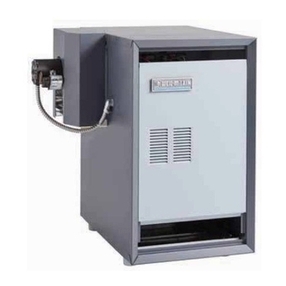
Weil-McLain
Weil-McLain CGi 4 Series manual

Bryan Boilers
Bryan Boilers BE Series Specification sheet
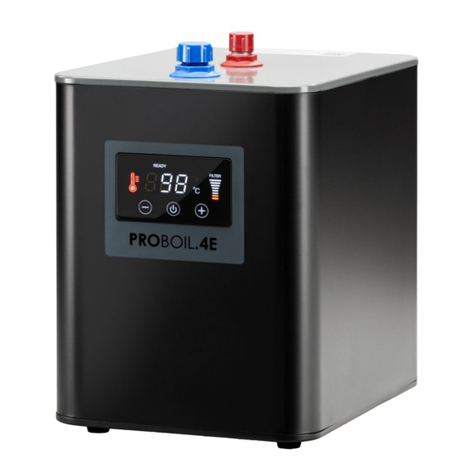
PROBOIL
PROBOIL PROBOIL.4E User's installation guide
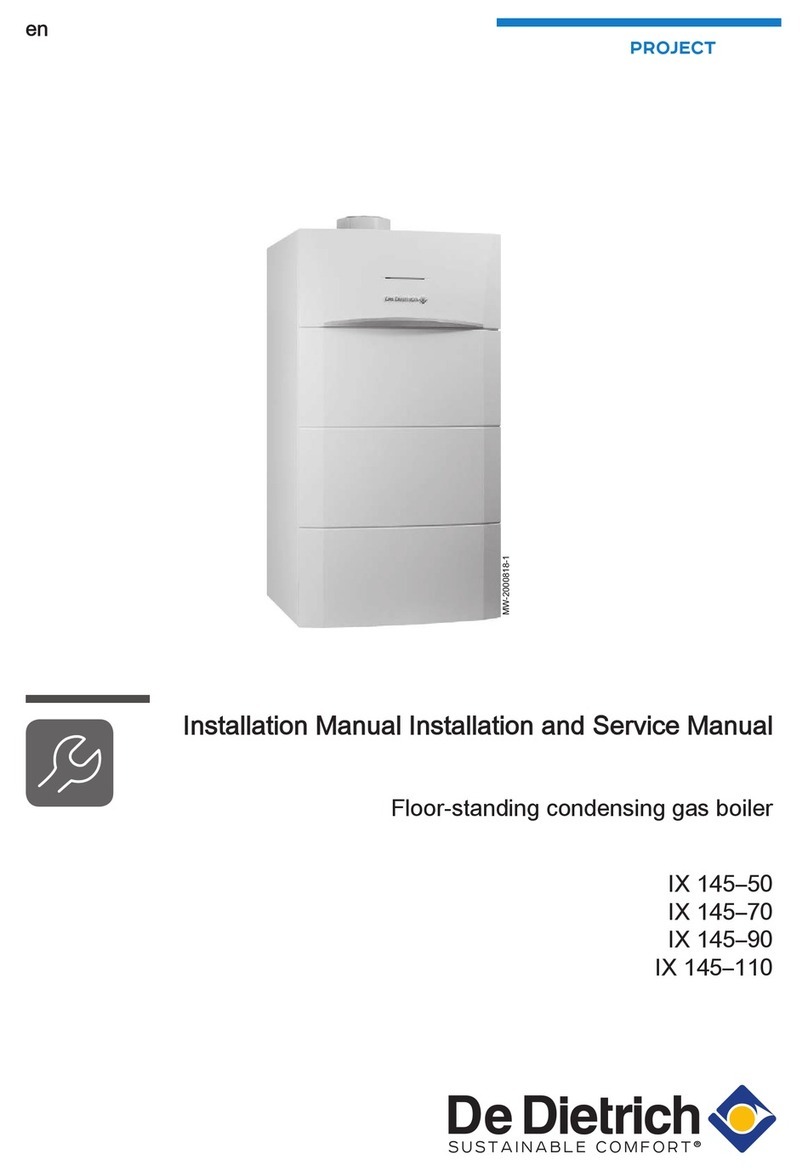
DeDietrich
DeDietrich IX 145-50 Installation and service manual
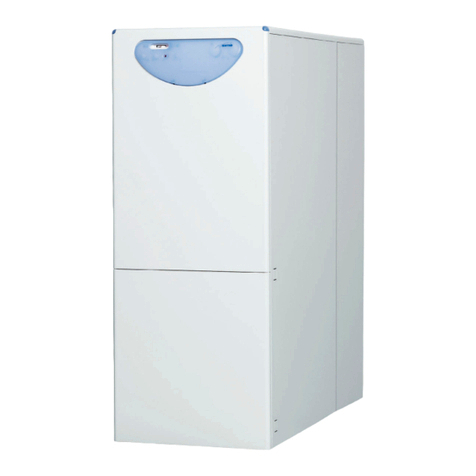
Sime
Sime AQUA HE 25 ErP BE Installer's instructions

Worcester
Worcester 12/18 instruction manual

Wolf
Wolf MGK-130 operating instructions
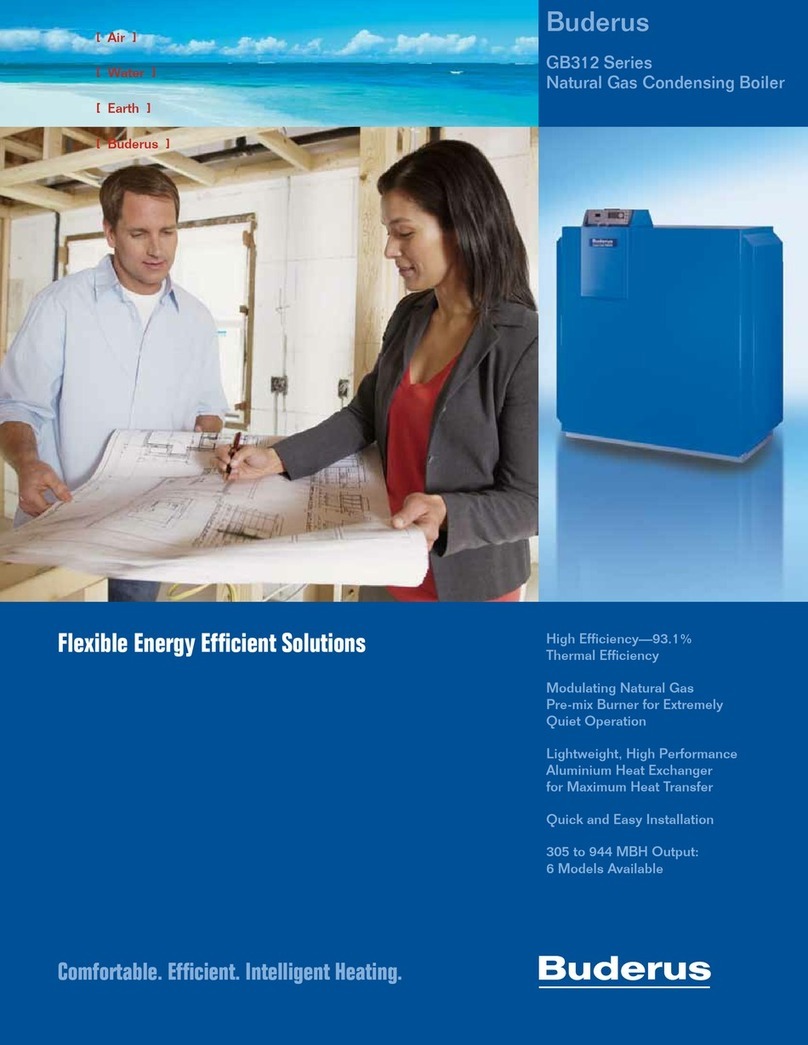
Buderus
Buderus GB312 Series Brochure & specs

Riello
Riello MINI 11 user manual
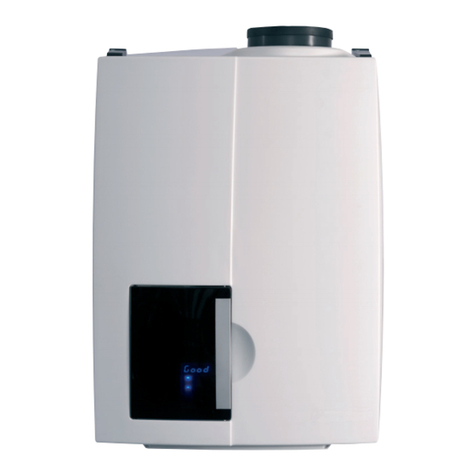
Rinnai
Rinnai E85SRN Installation & servicing instructions

New Yorker
New Yorker Classic CGS-A Series Installation, operating and service instructions
